Owls are among the most fascinating and mysterious birds in the world. Known for their silent flight, haunting calls, and nocturnal habits, these raptors have captivated human imagination for centuries. With over 250 owl species globally, they vary in size, coloration, and behavior—from the tiny Elf Owl of the desert to the majestic Snowy Owl of the Arctic tundra. This guide explores 41 types of owls, providing detailed identification tips, habitats, and fascinating facts that help birdwatchers and nature enthusiasts recognize and appreciate these incredible creatures. Whether you’re a beginner or an experienced birder, this article will help you understand the wonderful diversity of owls across the planet.
1. Barn Owl (Tyto alba)
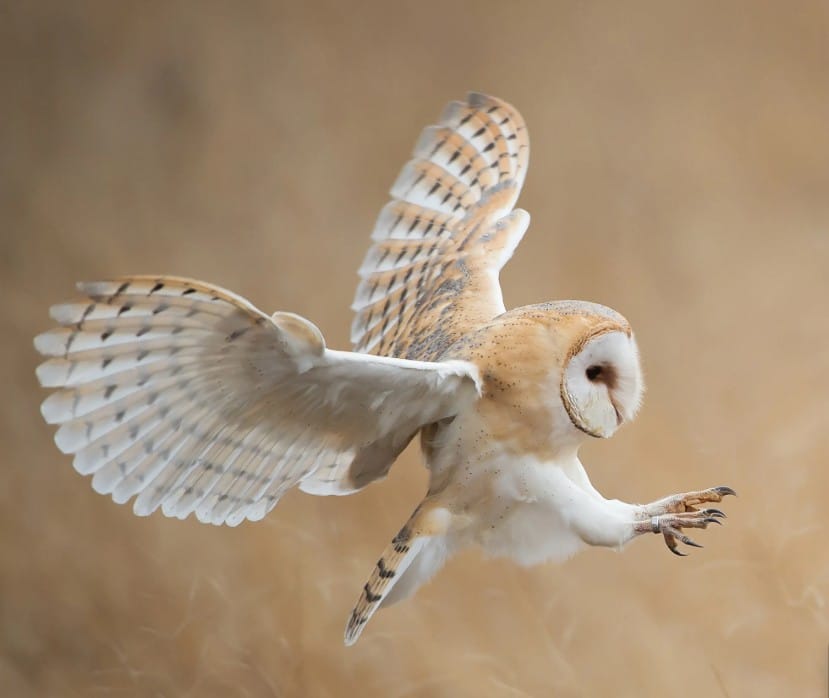
The Barn Owl is one of the most recognizable owl species, known for its heart-shaped face and ghostly white plumage. Found on every continent except Antarctica, it thrives in open farmland, grasslands, and even near human settlements where it hunts small rodents. Its pale feathers give it a ghost-like appearance in flight, and its ability to hunt silently makes it a symbol of stealth in many cultures.
Barn Owls have long wings and a short tail, allowing them to glide smoothly through the night. Their distinctive, screeching call—rather than a hoot—adds to their eerie charm. They have remarkable hearing, capable of pinpointing prey even in complete darkness. Instead of using sight alone, they rely on facial discs that funnel sound to their asymmetrical ears, giving them precise audio targeting. This makes them among the most efficient nocturnal hunters in the animal kingdom.
Conservation efforts worldwide are helping Barn Owl populations recover in areas where habitat loss and pesticide use once reduced their numbers. Installing nest boxes has proven successful in attracting breeding pairs. For bird enthusiasts, spotting a Barn Owl swooping over a moonlit field is one of the most enchanting wildlife encounters imaginable.
2. Great Horned Owl (Bubo virginianus)
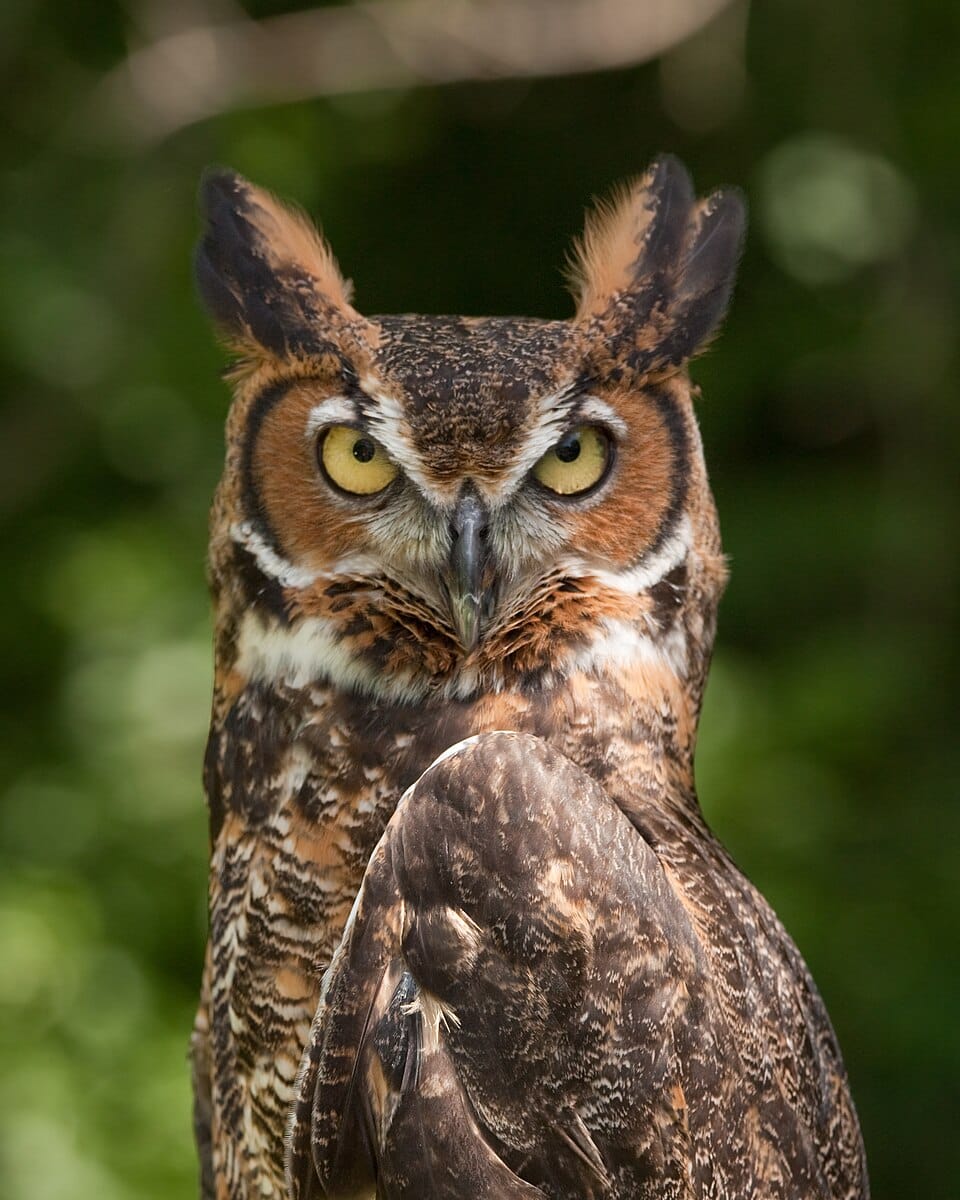
The Great Horned Owl is a powerful and adaptable predator native to the Americas. Recognized by its feathered “horns” or tufts and its deep hooting voice, this owl occupies diverse habitats—from dense forests and deserts to city parks and farmlands. It’s sometimes nicknamed the “Tiger of the Sky” due to its fierce hunting style and broad prey range.
These owls have large, bright yellow eyes and mottled brown feathers that help them blend seamlessly into tree bark. They are known to prey on a wide range of animals, including rabbits, squirrels, skunks, and even other birds of prey. Their strong talons exert a crushing force that makes them one of the top avian predators in North America.
Great Horned Owls are early nesters, often laying eggs in January or February, even in snow. They don’t build their own nests but take over those of hawks or crows. Their adaptability, intelligence, and fierce demeanor make them icons of the wild. Observing one perched silently at dusk is an unforgettable experience for birdwatchers.
3. Snowy Owl (Bubo scandiacus)
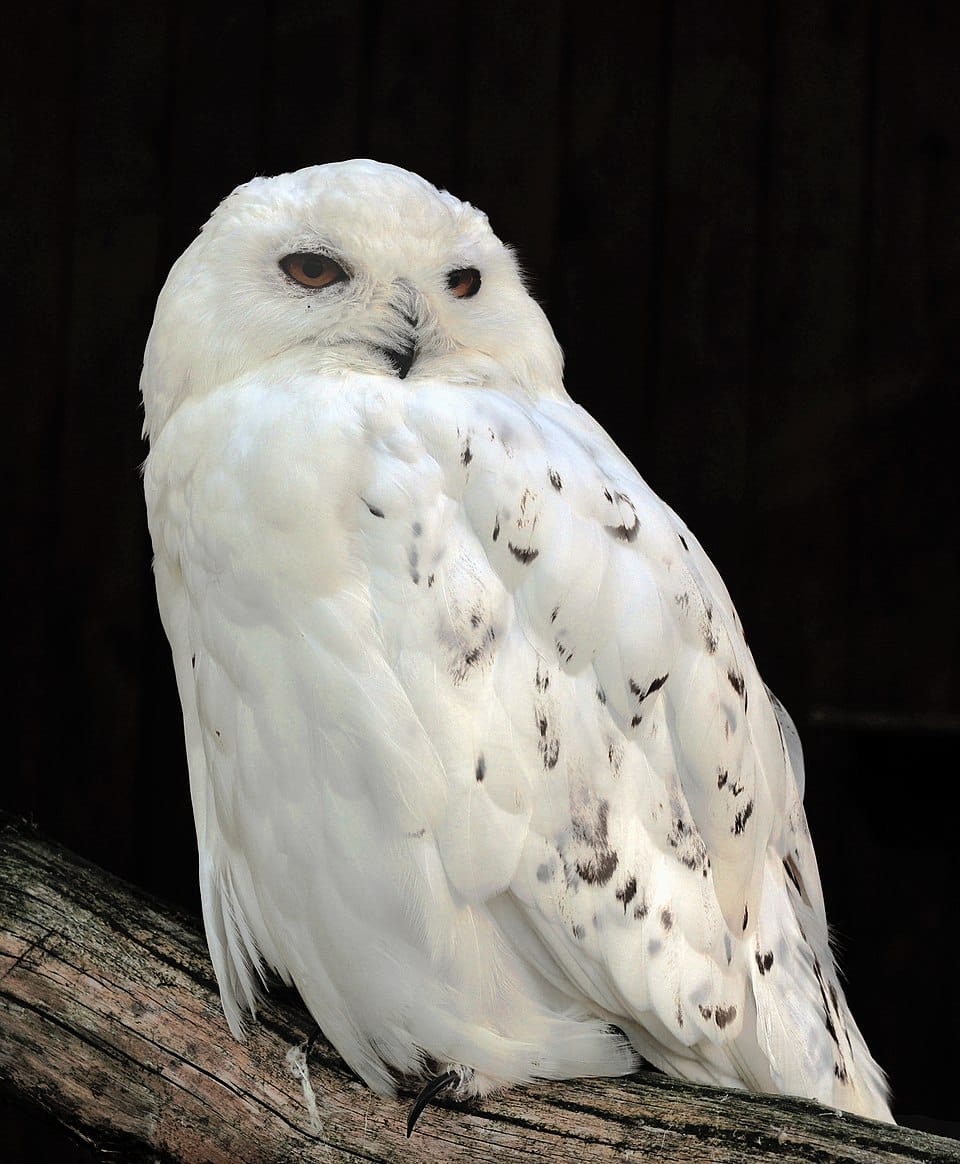
The Snowy Owl is a symbol of the Arctic wilderness and one of the most striking owl species on Earth. With its pure white plumage, golden eyes, and large size, it’s unmistakable in appearance. Unlike most owls, the Snowy Owl is diurnal, often active during the day when sunlight reflects off the tundra snow.
These owls breed in the Arctic tundra, where they nest on the ground and raise their young during the brief summer. Their population numbers often fluctuate with lemming cycles—their favorite prey. When food is scarce in the far north, Snowy Owls migrate southward, sometimes appearing in large numbers in what’s known as an “irruption.”
Snowy Owls are powerful fliers, capable of covering vast distances. They symbolize endurance and mystery in many cultures, famously represented as Hedwig in the Harry Potter series. Seeing one perched on a snowbank or fence post during winter is a bucket-list sighting for birders worldwide.
4. Eurasian Eagle-Owl (Bubo bubo)
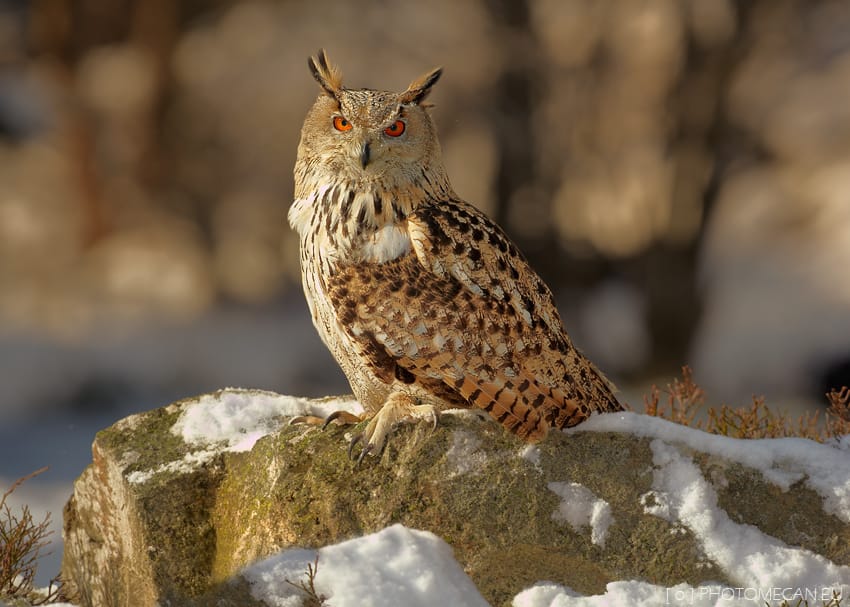
The Eurasian Eagle-Owl is one of the largest and most powerful owls on the planet. With its striking orange eyes, broad wingspan, and dramatic ear tufts, it exudes majesty. Native to Europe and Asia, this species thrives in forests, cliffs, and mountainous areas, where it commands the night sky as an apex predator.
Adult Eurasian Eagle-Owls can have a wingspan exceeding 6 feet (nearly 2 meters). Their plumage is beautifully mottled in shades of brown, black, and cream, providing excellent camouflage against rocky terrain. They primarily hunt mammals such as hares and rodents, but are also known to catch foxes and large birds.
Despite their formidable reputation, these owls form strong pair bonds and show great care in raising their young. Conservation programs have successfully reintroduced them into parts of Western Europe where they were once extinct. Their haunting call, a deep “ooh-hu,” echoes through forested valleys and cliffs—one of the most unforgettable sounds of the night.
5. Barred Owl (Strix varia)
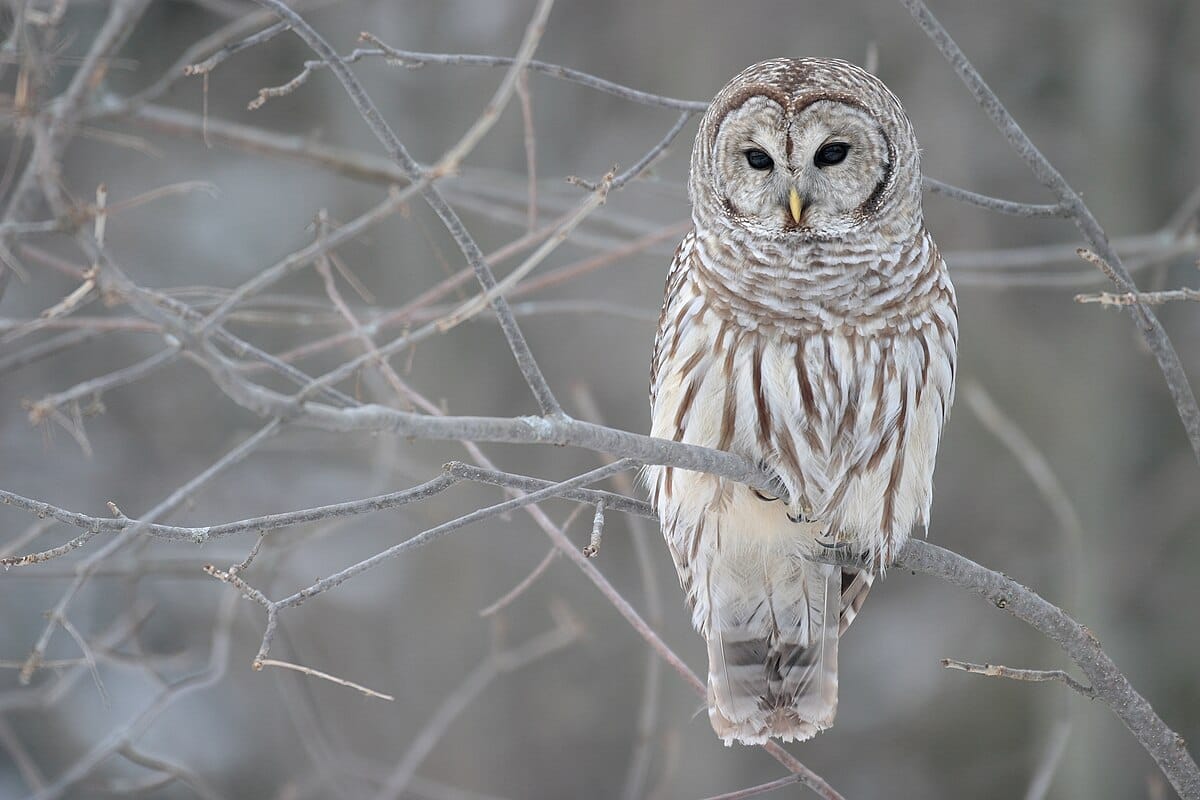
The Barred Owl, with its soulful dark eyes and distinctive “Who cooks for you? Who cooks for you all?” call, is one of North America’s most endearing owl species. Its name comes from the horizontal barring on its chest and vertical streaks on its belly. Found in mature forests, particularly near swamps and rivers, it prefers dense canopy cover.
Barred Owls are stocky, medium-to-large-sized birds with rounded heads and no ear tufts. They hunt mostly at night but are sometimes active in the early morning or late afternoon. Their diet includes mice, frogs, snakes, and even small birds. Unlike many owls, they are known to be relatively curious and tolerant of humans, often perching calmly near walking trails.
Over the past century, Barred Owls have expanded their range westward, even into regions once dominated by the Northern Spotted Owl—creating ecological challenges. Despite this, they remain a favorite among bird enthusiasts for their expressive faces, rich calls, and adaptability. Listening to their duet calls under a moonlit forest canopy is a magical experience for anyone who loves the wild.
6. Spotted Owl (Strix occidentalis)
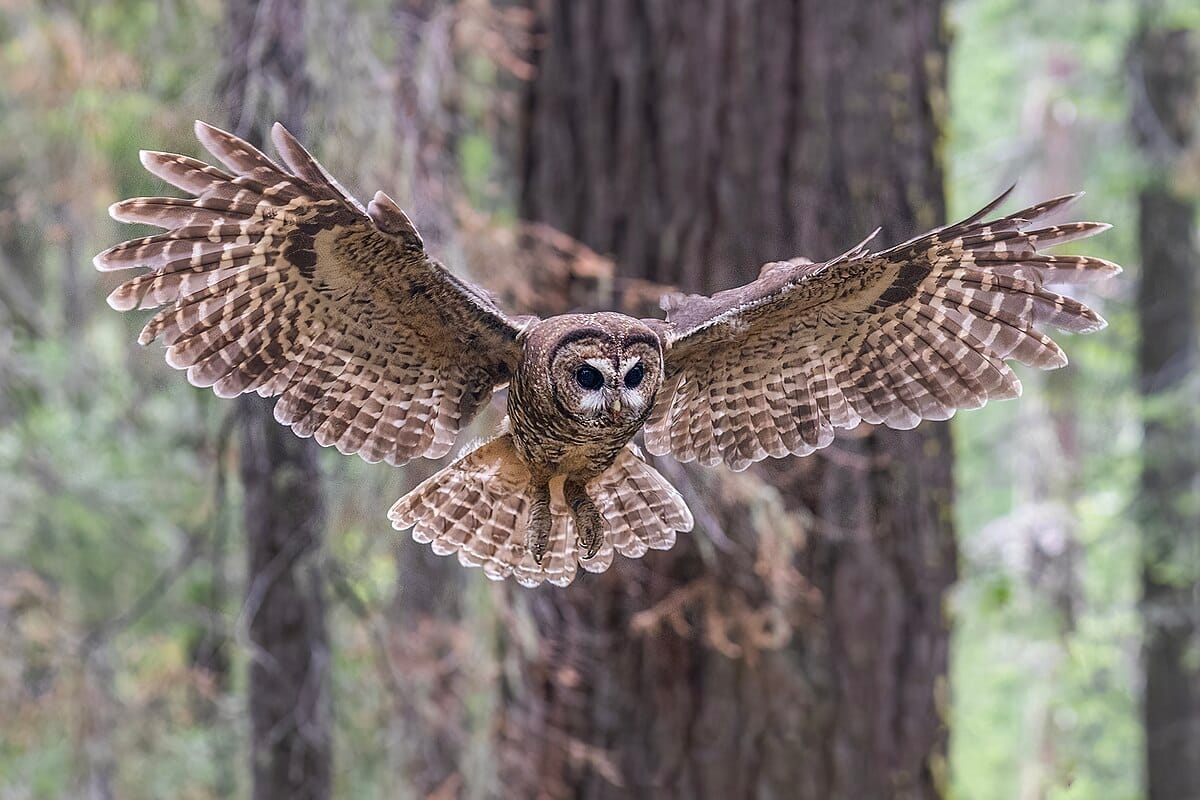
The Spotted Owl is a symbol of the old-growth forests of North America, particularly in the Pacific Northwest. This medium-sized owl is easily identified by its rich brown plumage dotted with white spots, dark eyes, and rounded head without ear tufts. Unlike its close relatives, it prefers dense, mature forests with towering trees and deep canopies—habitats that are unfortunately shrinking due to logging and development.
Spotted Owls are primarily nocturnal and specialize in hunting small mammals like flying squirrels and woodrats. They perch silently and glide between branches with barely a sound, thanks to their specially adapted feathers. Their hoots are rhythmic and mellow, echoing softly through the forest. These owls mate for life, nesting in tree cavities or broken snags and fiercely defending their territory.
Sadly, the Spotted Owl has become one of the most studied birds in conservation biology due to habitat loss and competition from the invasive Barred Owl. Efforts to protect their forest homes have made this species a symbol of the delicate balance between industry and ecology. Seeing one in the wild is a rare and treasured experience—an encounter with a true guardian of the forest.
7. Tawny Owl (Strix aluco)
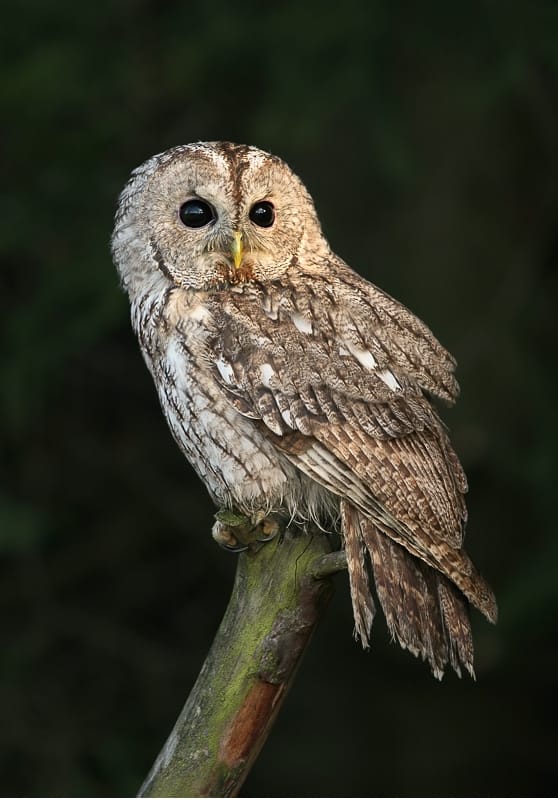
The Tawny Owl is one of Europe’s most familiar nocturnal birds, easily recognized by its rounded face, dark soulful eyes, and classic “hoo-hoo” call that defines nighttime in woodlands. These medium-sized owls have a variety of color morphs, ranging from reddish-brown to gray, which helps them blend seamlessly into tree bark during the day.
Found across Europe and parts of Asia, Tawny Owls inhabit forests, gardens, and even city parks. They are territorial birds that rarely migrate, preferring to stay within their woodland domains year-round. They hunt mostly small mammals and birds, striking silently from a perch. Their flight is ghostlike—swift and soundless—thanks to fringed feathers that muffle noise.
Tawny Owls are often the first owls people encounter in the wild due to their adaptability. Their eerie yet beautiful hoots often form duets between mates, creating the quintessential “owl sound” of folklore. Despite their common status, they are highly intelligent and secretive, embodying the mysterious allure that has made owls cultural icons for centuries.
8. Ural Owl (Strix uralensis)
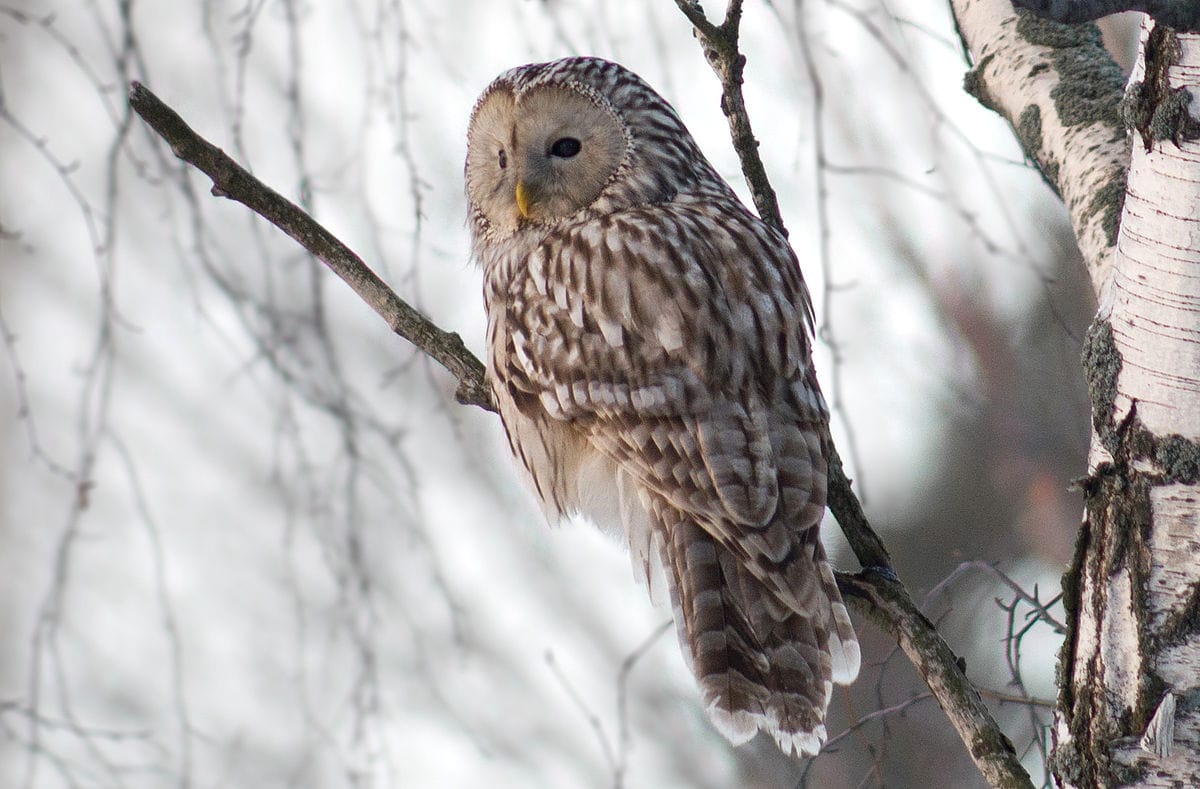
The Ural Owl is a large, pale-gray owl found across northern Europe and Asia, known for its calm demeanor and elegant appearance. It inhabits boreal forests, preferring areas with a mix of conifers and birch trees. With its long tail, rounded wings, and soft facial disc, the Ural Owl has a distinctive silhouette in flight.
Unlike many owls, the Ural Owl is active both day and night, especially during the breeding season when food demands are high. Its call is a series of deep, rhythmic hoots that can be heard over long distances. They feed primarily on voles and small rodents but will also take small birds and amphibians.
The species is known for its fierce defense of its nest—so much so that hikers in some regions wear hats or helmets to avoid surprise attacks during nesting season! Despite their protective nature, Ural Owls are admired for their serene, intelligent expression and are a favorite among European bird photographers. Their presence in a forest is a sign of a healthy, balanced ecosystem.
9. Great Gray Owl (Strix nebulosa)
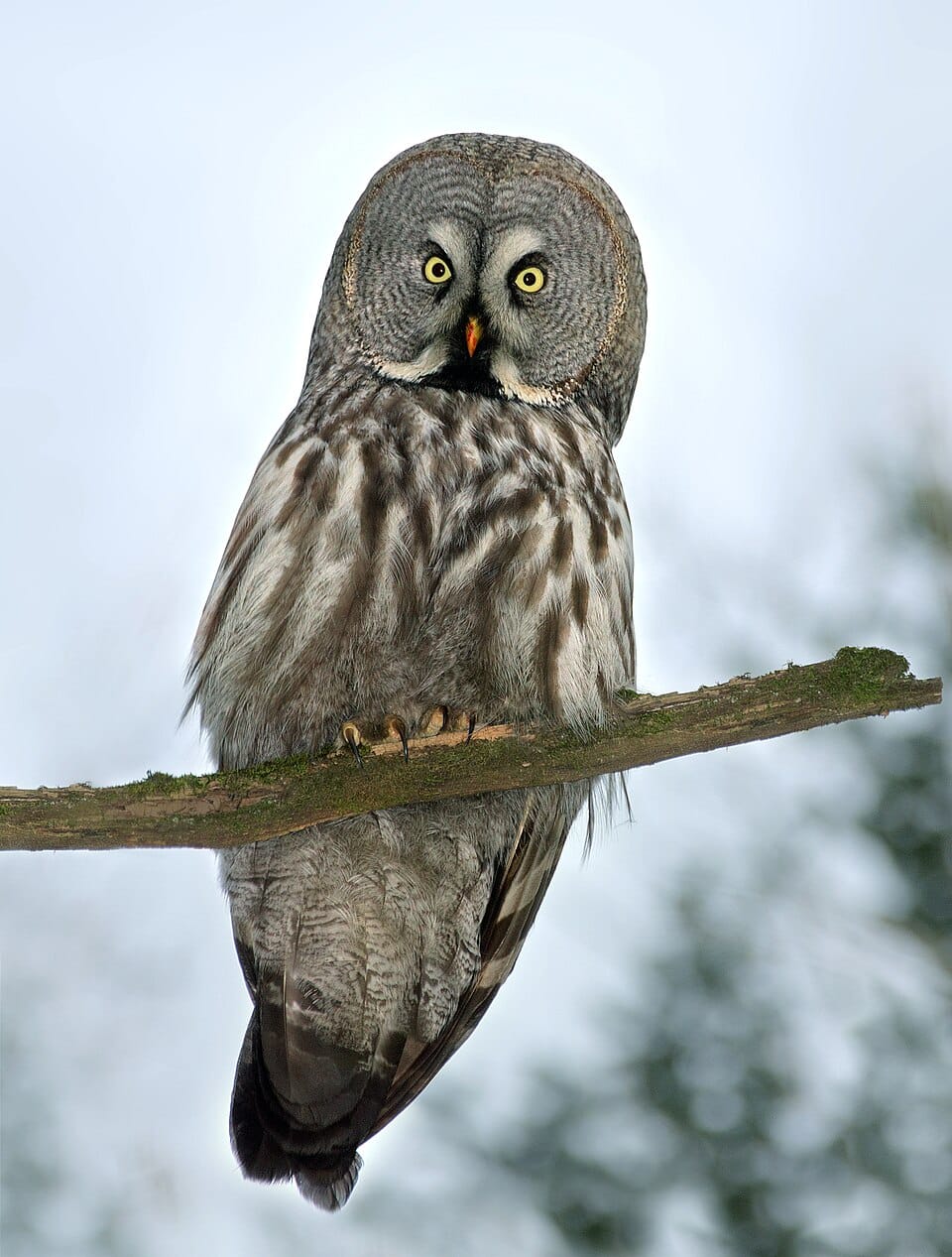
The Great Gray Owl is one of the most majestic owls in the world. Known as the “Phantom of the North,” it’s the largest owl by length, with a wingspan reaching up to 5 feet. Despite its size, it’s relatively light because of its fluffy feathers. This owl’s striking facial disc, framed by concentric gray rings, makes it one of the most photogenic birds on the planet.
Found across northern North America and Eurasia, the Great Gray Owl prefers dense boreal forests interspersed with open meadows where it hunts voles, mice, and other small mammals. Its hearing is extraordinarily sharp—it can detect prey moving under deep snow and plunge through it to capture a meal.
These owls are elusive and quiet, often sitting motionless for long periods while scanning for prey. Their haunting calls echo softly through the cold forest air. Observing one is a breathtaking experience, not just for its beauty but for the sense of wilderness it represents. The Great Gray Owl is a symbol of patience, power, and the unbroken spirit of the wild north.
10. Northern Hawk Owl (Surnia ulula)
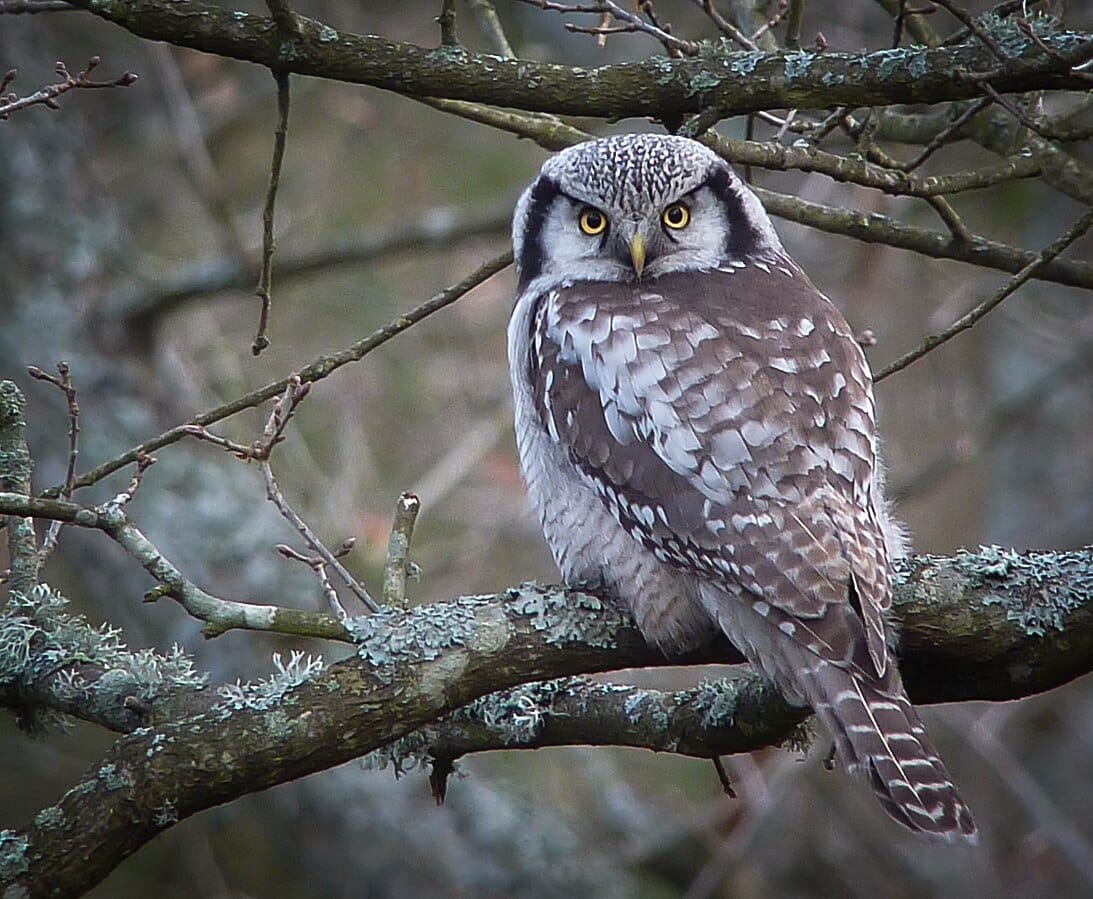
The Northern Hawk Owl is a fascinating species that bridges the characteristics of hawks and owls. Its long tail, slender body, and daytime hunting habits make it look and act much like a hawk, though it’s unmistakably an owl in taxonomy and behavior. Found in northern boreal forests across Canada, Alaska, and Scandinavia, this species thrives in cold climates with open spaces for hunting.
Unlike most owls, the Northern Hawk Owl is largely diurnal, active during daylight hours. It perches high on trees or poles to scan the ground for movement, swooping down swiftly to catch small mammals or birds. Its eyesight is exceptional, allowing it to spot prey up to half a mile away—a rare ability among owls that rely more on hearing.
Despite its remote habitat, the Northern Hawk Owl occasionally ventures south during winter irruptions, delighting birders with its boldness and charisma. It often perches in the open, making it a photographer’s dream subject. Its combination of grace, intelligence, and hunting prowess makes it one of the most remarkable owls in the northern hemisphere.
11. Burrowing Owl (Athene cunicularia)
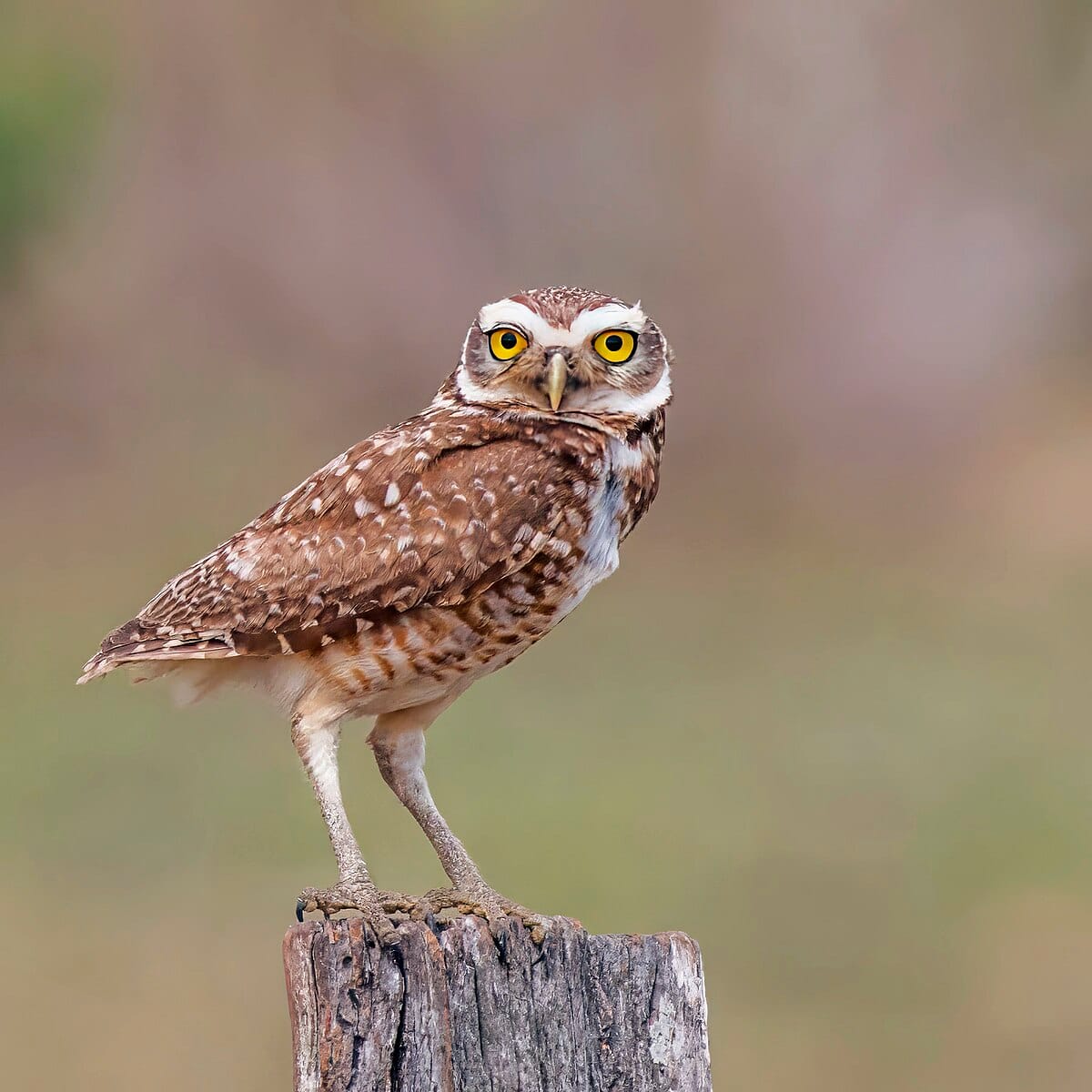
The Burrowing Owl is one of the most unique owl species in the world because it spends much of its life on the ground rather than in trees. Native to the grasslands, prairies, and deserts of the Americas, these small, long-legged owls inhabit burrows dug by mammals such as prairie dogs or ground squirrels. With their bright yellow eyes and expressive faces, they’ve become favorites among birdwatchers and photographers alike.
Burrowing Owls are diurnal, meaning they are active during the day, especially at dawn and dusk. Their diet mainly consists of insects and small mammals, but they also eat reptiles and amphibians. Unlike most owls, they can run and hop quickly on the ground, giving them a comical yet endearing appearance. They often stand tall near their burrow entrances, bobbing their heads curiously when approached.
These owls are also known for their charming behaviors—they decorate the entrances of their burrows with dung, which attracts insects that they later catch for food. Sadly, habitat destruction and the decline of burrowing mammals have reduced their populations in some regions. Conservationists are working to preserve open grasslands and create artificial burrows to help protect this charismatic species.
12. Little Owl (Athene noctua)
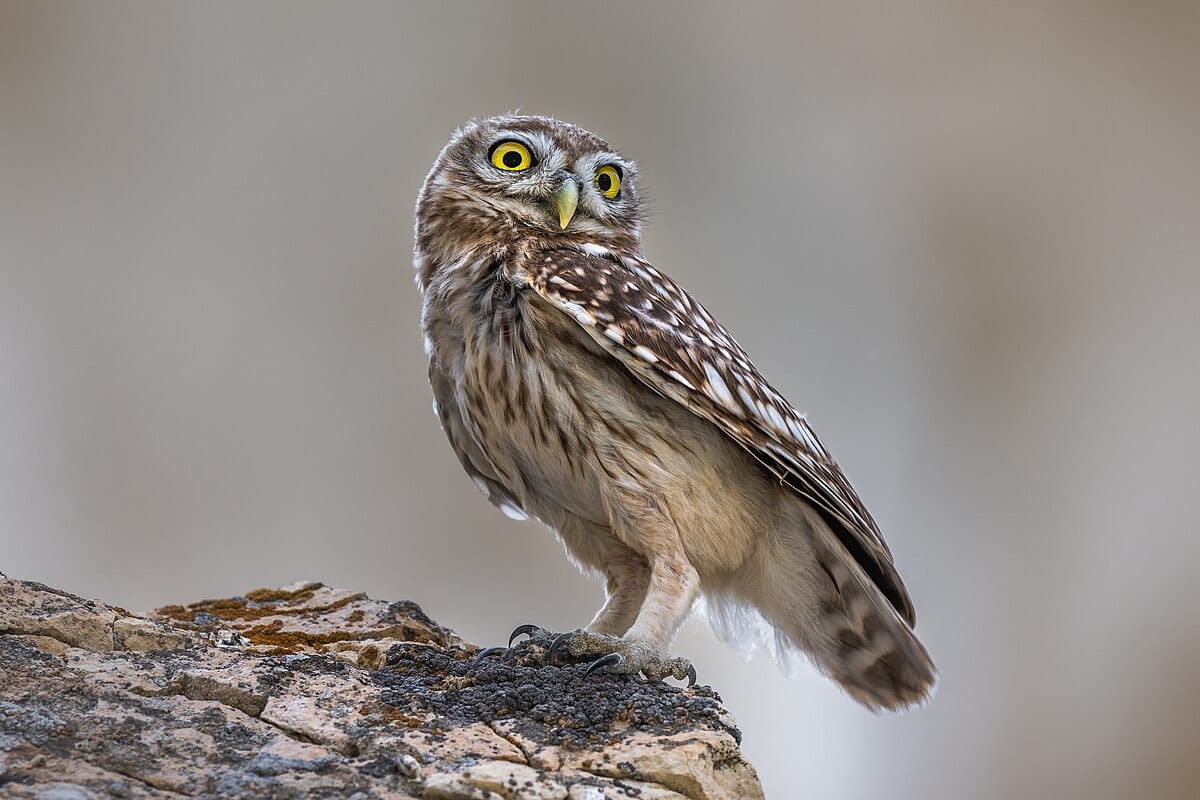
The Little Owl is a small but bold species native to Europe, Asia, and parts of North Africa. Despite its size, it has a feisty personality and is known for standing its ground against much larger birds. Its mottled brown and white plumage provides excellent camouflage among rocks, trees, and even rural buildings. With its flat-topped head and piercing yellow eyes, the Little Owl is instantly recognizable.
It prefers open landscapes such as farmlands, orchards, and grasslands, where it perches on fence posts or walls to hunt insects, small mammals, and birds. These owls are crepuscular, active during dawn and dusk, and often seen bobbing their heads before swooping down to catch prey. Unlike many nocturnal species, the Little Owl is often spotted during daylight, which makes it a delight for nature watchers.
In mythology and culture, the Little Owl is famously associated with Athena, the Greek goddess of wisdom, symbolizing intelligence and watchfulness. Despite facing threats from agricultural changes and habitat loss, this resilient species continues to adapt to human-altered environments. Its confident demeanor and adaptability make it one of the most admired owls in Europe.
13. Elf Owl (Micrathene whitneyi)
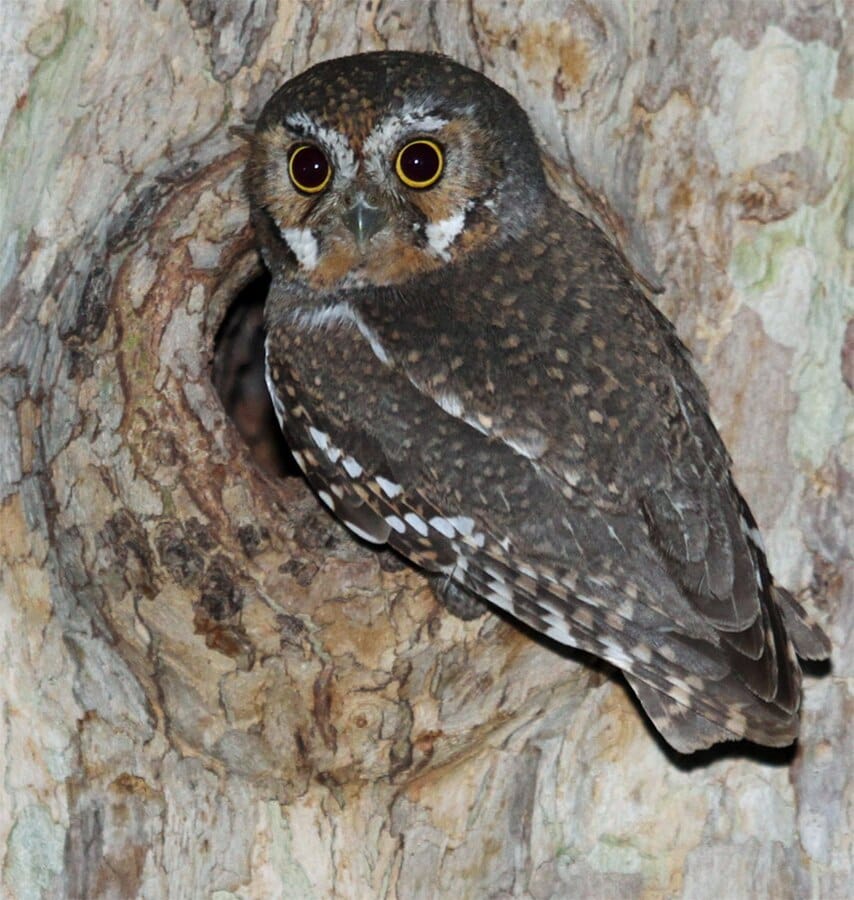
The Elf Owl holds the title of the world’s smallest owl, standing only about 5 to 6 inches tall and weighing less than 2 ounces. Native to the southwestern United States and Mexico, this tiny bird inhabits deserts, canyons, and saguaro cactus forests. Despite its diminutive size, the Elf Owl has a big personality and impressive survival skills.
Elf Owls are nocturnal insect hunters, preying primarily on beetles, moths, and crickets. They nest in old woodpecker holes in cacti or trees, using their small stature to hide from predators. When threatened, they may feign death or disappear silently into the shadows. Their soft, high-pitched calls echo faintly through desert nights, giving away their presence to those who listen carefully.
These owls migrate seasonally, spending winters in Mexico and returning north to breed in spring. Though small, the Elf Owl plays an important ecological role by controlling insect populations in arid environments. Its cuteness and resilience have made it a favorite symbol of desert wildlife, and its conservation success is a testament to the power of preserving natural habitats.
14. Flammulated Owl (Psiloscops flammeolus)
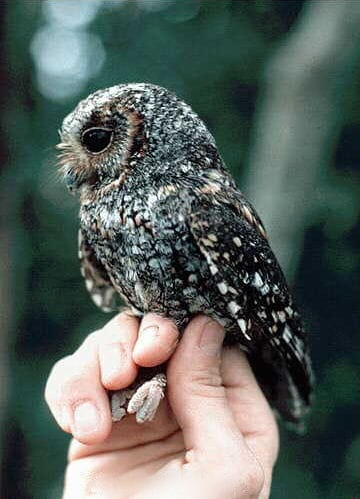
The Flammulated Owl is a small, secretive owl native to western North America. Its name comes from the Latin “flammeolus,” meaning “flame-colored,” referring to the reddish or orange tones in its feathers. This subtle coloration, combined with its bark-like plumage, provides perfect camouflage in pine and fir forests where it breeds during summer.
These owls are migratory, traveling to Central America during winter—an unusual trait among small owl species. They are nocturnal and feed mainly on insects, especially moths and beetles. Despite their small size, they have a deep, soft hoot that sounds surprisingly large for their body. Because of their secretive habits, Flammulated Owls are more often heard than seen.
They prefer nesting in old woodpecker holes and rely on mature forests for survival. Conservationists emphasize the importance of protecting old-growth trees to maintain their populations. Birdwatchers treasure sightings of this elusive species, as its camouflage and quiet nature make encounters rare and rewarding. The Flammulated Owl is truly a hidden gem of North America’s mountain forests.
15. Eastern Screech Owl (Megascops asio)
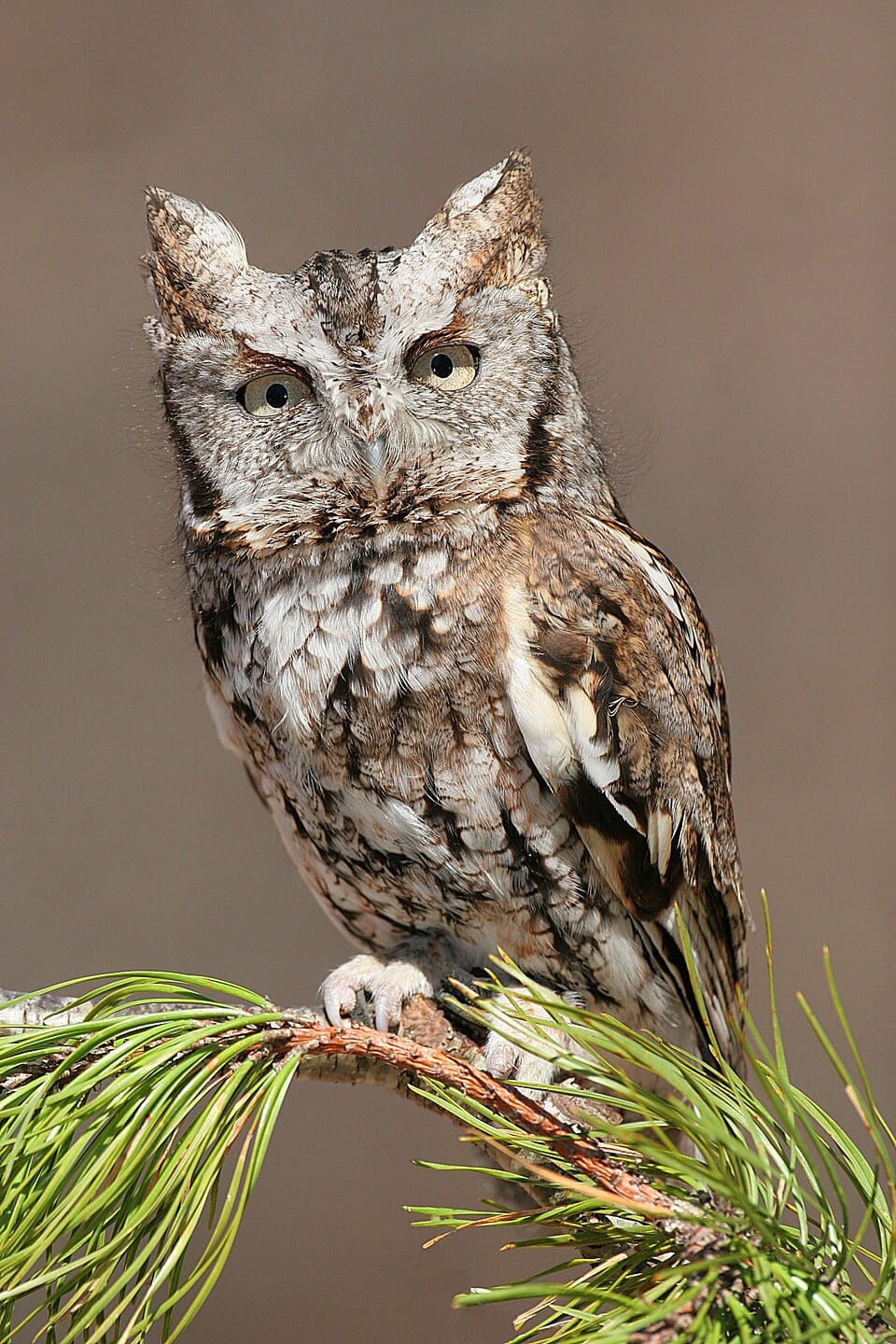
The Eastern Screech Owl is one of the most adaptable and widespread owls in eastern North America. Despite its name, it doesn’t actually “screech” but rather produces a soft, haunting trill or descending whinny that echoes through forests and suburban neighborhoods. This small owl comes in two color morphs—gray and red—both providing excellent camouflage against tree bark.
Eastern Screech Owls inhabit a wide range of environments, from woodlands and parks to backyards and city edges. They hunt insects, rodents, and small birds, often catching prey in mid-flight. During the day, they remain motionless against tree trunks, virtually invisible to passersby. At night, they become agile hunters with sharp vision and hearing.
These owls readily use nest boxes, making them favorites for backyard bird enthusiasts. Their calm temperament and adaptability to human environments have allowed them to thrive even as other owl species decline. Watching one peek out from a tree hollow or hearing its gentle trill on a summer night is one of the quiet joys of connecting with nature close to home.
16. Western Screech Owl (Megascops kennicottii)
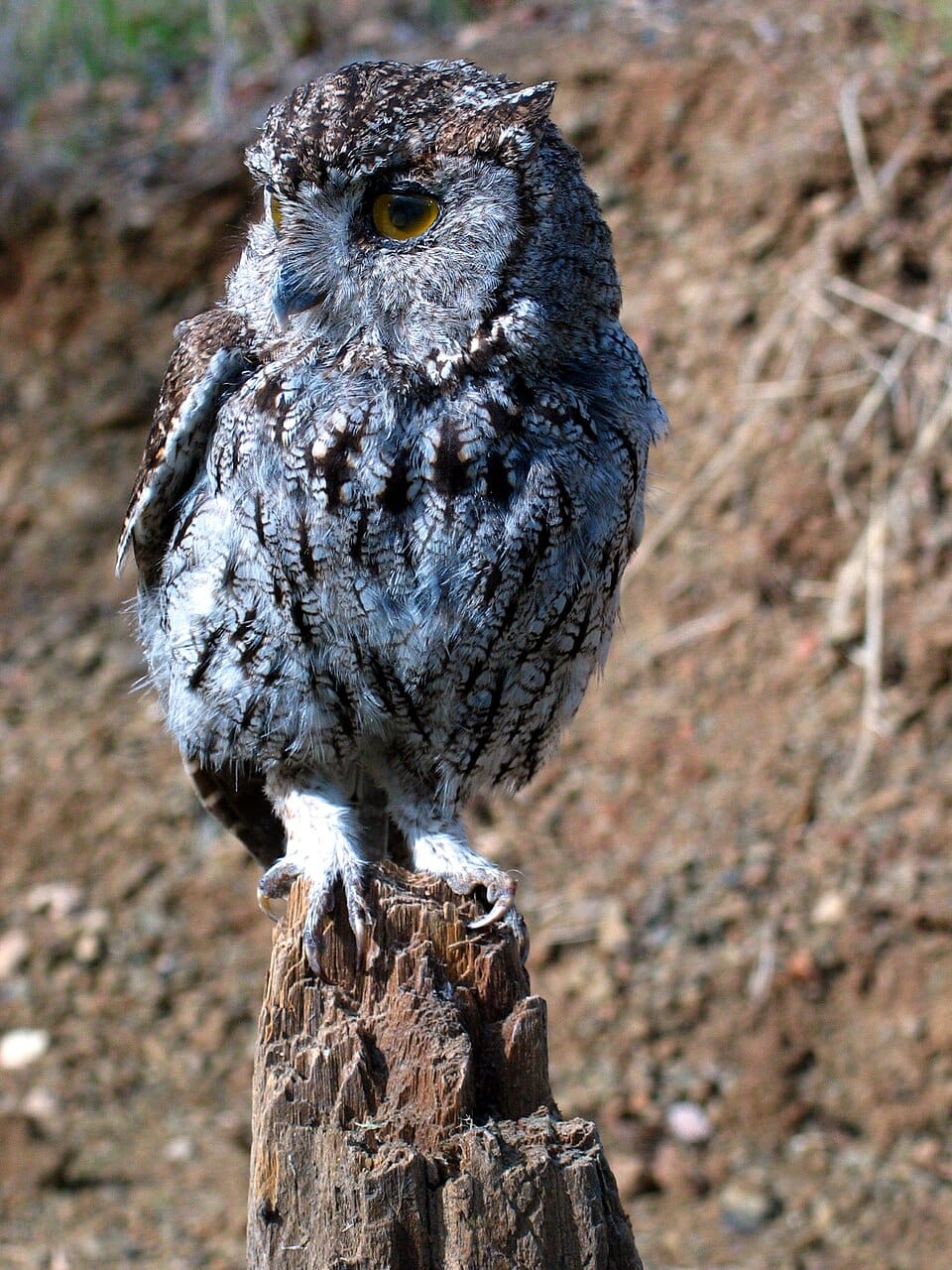
The Western Screech Owl is a small but resilient species native to North and Central America. It closely resembles the Eastern Screech Owl, but its range covers the western regions of the continent—from Alaska and British Columbia to Mexico. These owls inhabit deserts, forests, and even urban areas, proving to be among the most adaptable nocturnal birds in the West.
Western Screech Owls are masters of camouflage. Their mottled gray or brown plumage allows them to blend perfectly into tree bark, making them nearly invisible during the day. At night, they emerge to hunt insects, rodents, and small birds. Despite their small size, they are fierce predators, capable of tackling prey nearly half their weight. Their call is a distinctive series of soft toots that sound like a bouncing ball—often heard on quiet desert evenings.
These owls nest in tree cavities or nest boxes, often reusing woodpecker holes. They form strong pair bonds, and both parents share in raising the young. Because they adapt well to both wilderness and suburban life, the Western Screech Owl has become a beloved neighbor in many parts of the American West. Seeing one perched on a cactus or fence post at dusk is a rewarding sight for birders and photographers alike.
17. Whiskered Screech Owl (Megascops trichopsis)
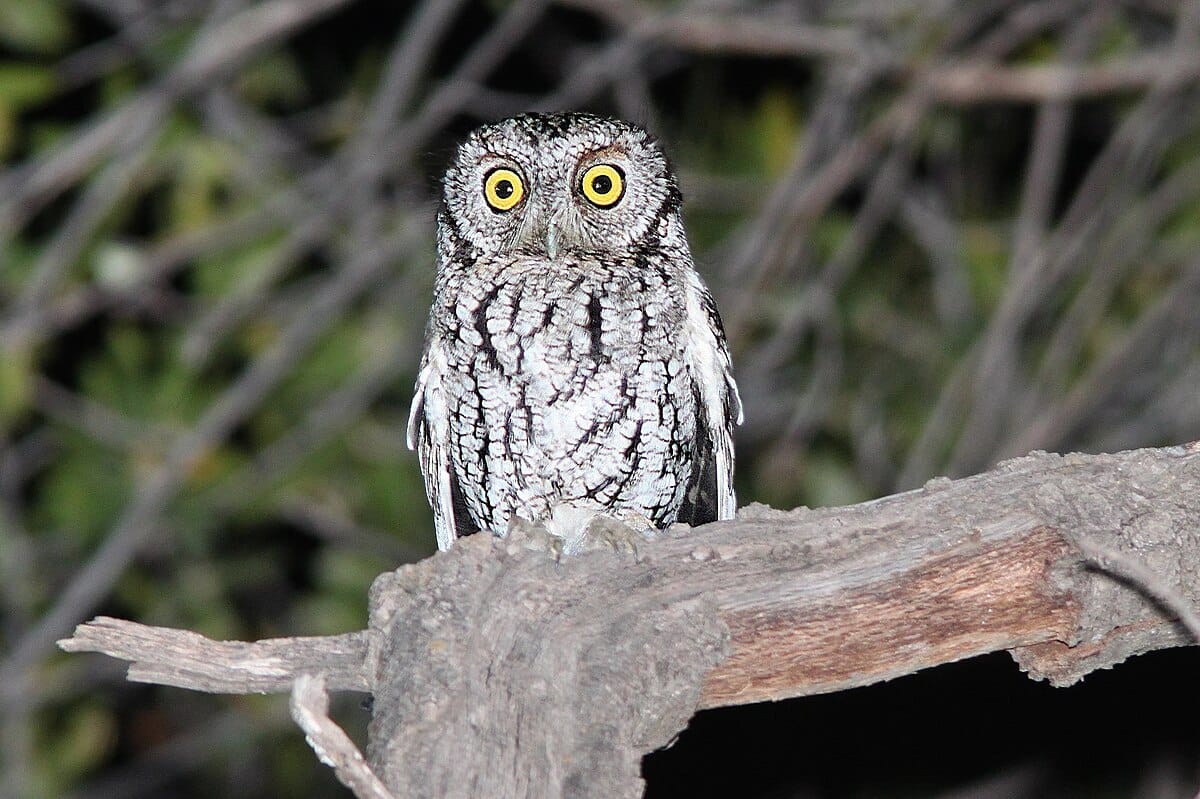
The Whiskered Screech Owl is one of the lesser-known but charming owl species native to the mountain forests of Mexico, Central America, and parts of the southern United States, particularly Arizona and New Mexico. It gets its name from the fine feather “whiskers” around its face, which give it an inquisitive expression. This small owl thrives in pine-oak woodlands and tropical montane forests.
Despite its resemblance to other screech owls, the Whiskered Screech Owl can be distinguished by its darker, finely streaked plumage and its soft, rhythmic trilling call. It is a nocturnal insectivore, feeding primarily on moths, beetles, and crickets. During the day, it roosts quietly in dense foliage or old woodpecker holes, relying on its perfect camouflage for protection.
These owls are rarely seen but often heard by experienced birders who recognize their distinctive nighttime calls. They are non-migratory and highly territorial, often returning to the same nesting sites year after year. Their presence is an indicator of healthy mountain ecosystems, making them an important species for forest conservation. The Whiskered Screech Owl may be small, but its quiet grace and beauty make it a treasured find for anyone lucky enough to spot one in the wild.
18. Puerto Rican Screech Owl (Megascops nudipes)
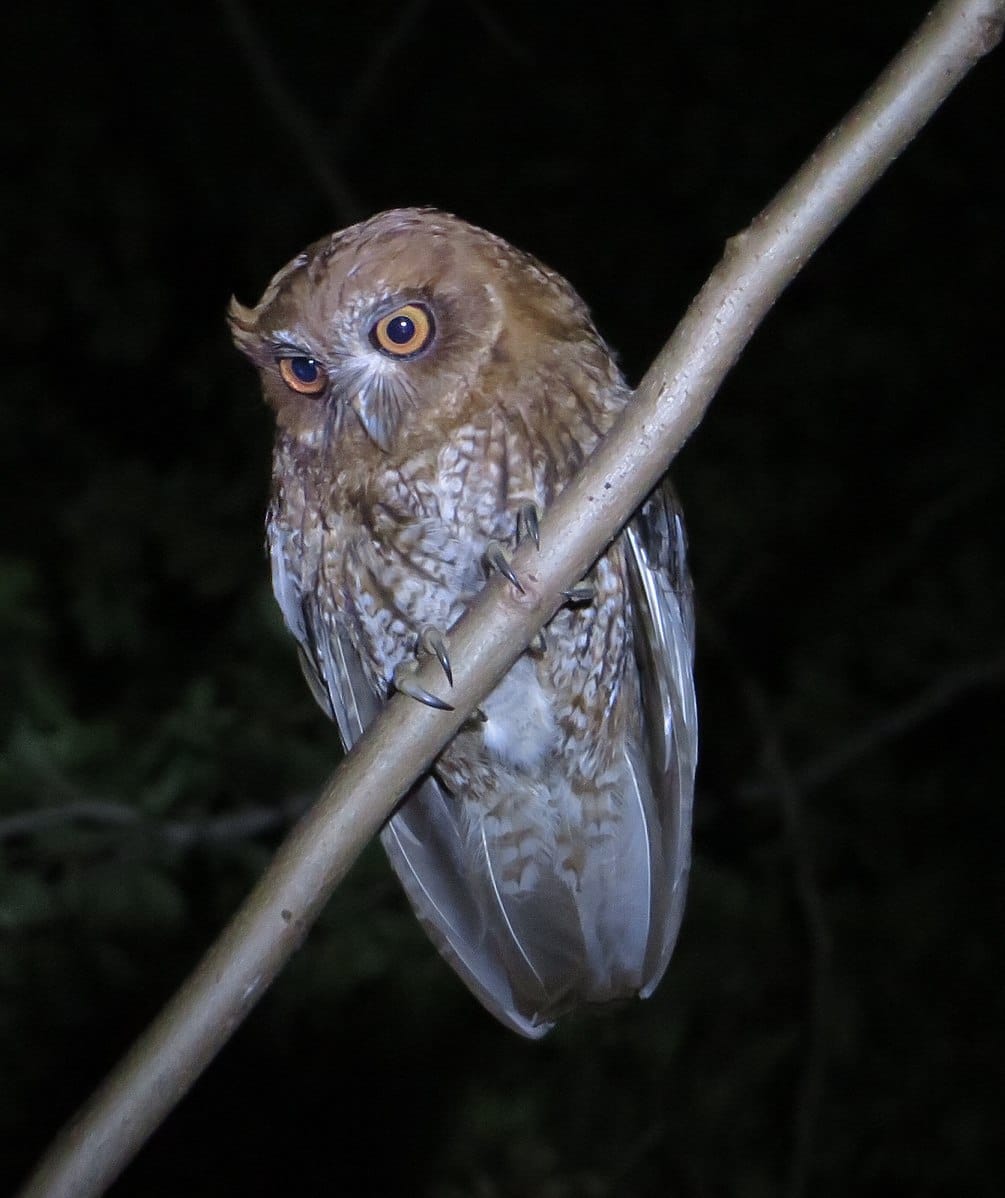
The Puerto Rican Screech Owl, also known as the Múcaro, is an endemic species found only in Puerto Rico. This small owl holds special cultural significance on the island, featuring in local folklore and stories as a symbol of wisdom and mystery. Its scientific name, Megascops nudipes, means “bare-footed,” referring to the lack of feathers on its lower legs—an unusual trait among owls.
With its brown plumage, dark eyes, and soft trills, the Puerto Rican Screech Owl blends perfectly into tropical forests and mangroves. It is primarily nocturnal and feeds on insects, small reptiles, and amphibians. These owls prefer lowland forests but have adapted to higher elevations as well, including the El Yunque National Forest. During the day, they hide in tree hollows or dense vegetation, emerging at night to hunt under the cover of darkness.
Sadly, habitat loss due to deforestation has made this species vulnerable. Conservation programs in Puerto Rico are actively protecting forest habitats to ensure the Múcaro continues to thrive. Hearing its haunting trills echo through the Caribbean night is a magical experience that connects locals and visitors alike to the island’s wild heart.
19. Spectacled Owl (Pulsatrix perspicillata)
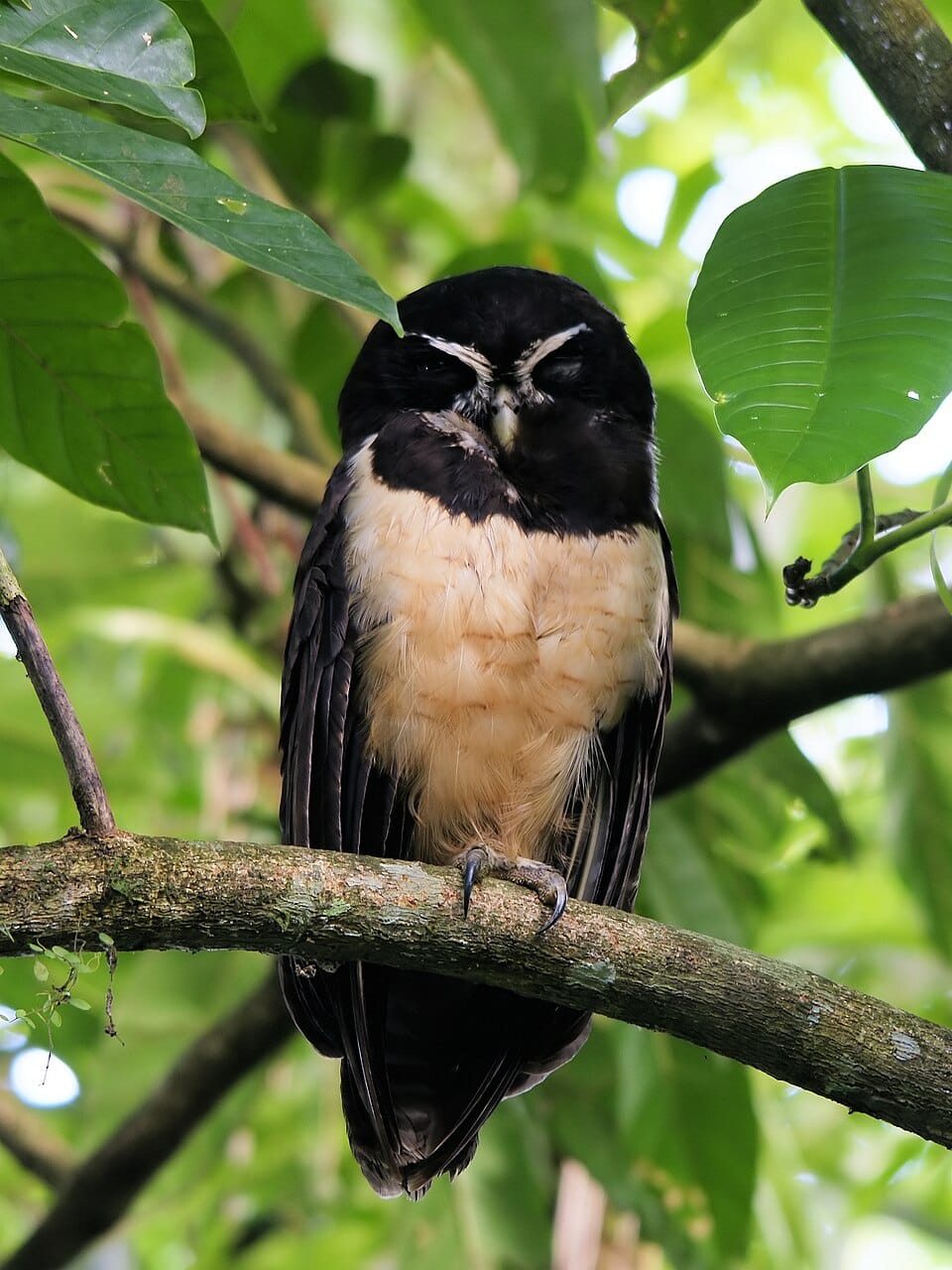
The Spectacled Owl is a striking and powerful bird native to the tropical forests of Central and South America. Its name comes from the distinctive white “spectacles” around its yellow eyes, which stand out sharply against its dark chocolate-brown head and back. The creamy-white chest and belly complete its dramatic appearance, making it one of the most photogenic owls in the Americas.
This medium-to-large species prefers dense rainforests but is also found in secondary forests and plantations. It is primarily nocturnal, hunting rodents, bats, and large insects under the cover of night. Its deep, resonant call—sounding like a pulsing “BOO-boo-boo-boo”—can be heard echoing through tropical forests, often mistaken for a distant drumbeat.
Spectacled Owls are solitary by nature, often seen perched silently for hours while scanning for movement below. They play a vital ecological role as apex predators, helping regulate small mammal populations. Despite their shy habits, they are occasionally spotted near forest edges or riverbanks. Their combination of beauty, strength, and mystery makes the Spectacled Owl a favorite subject for wildlife photographers and ecotourists exploring the jungles of Latin America.
20. Crested Owl (Lophostrix cristata)
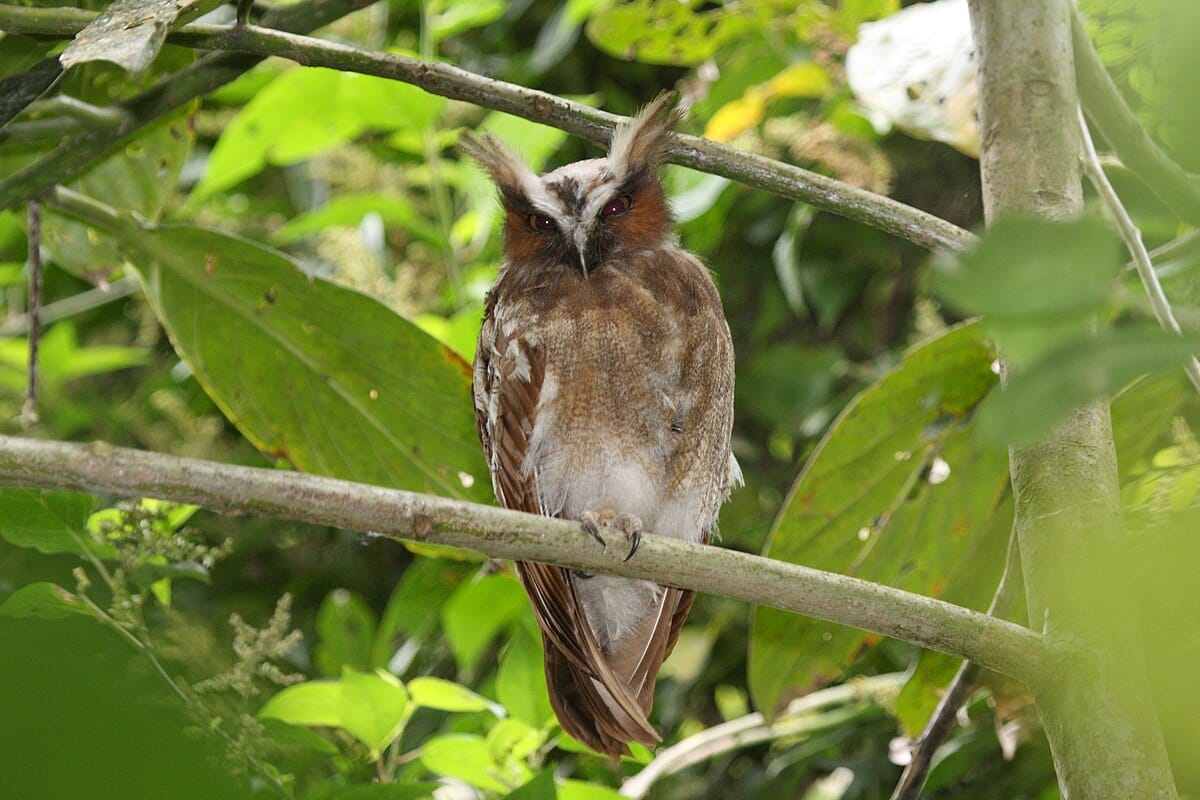
The Crested Owl is one of the most visually distinctive owls in the world, easily recognized by its long, white, wispy crest feathers that extend upward like dramatic eyebrows. Found in Central and South America, it inhabits lowland rainforests, favoring shaded areas near rivers or swamps. Despite its striking appearance, it is an elusive and secretive species rarely seen even by experienced birders.
These owls are medium-sized, with dark brown plumage, white facial discs, and bright orange eyes. Their eerie, deep calls resemble a growling “grrr-ooo,” adding to their mysterious aura. Crested Owls are nocturnal, feeding on insects, frogs, and small mammals. During the day, they perch quietly in dense foliage, perfectly camouflaged among leaves and branches.
The Crested Owl’s beauty and rarity have made it a prized sighting for birdwatchers in the Amazon and Central American jungles. It plays an important role in tropical ecosystems by controlling insect populations and maintaining balance in the food web. For those lucky enough to glimpse one, the Crested Owl represents the untamed, mystical side of the rainforest—a living embodiment of nature’s artistry.
21. Northern Saw-whet Owl (Aegolius acadicus)
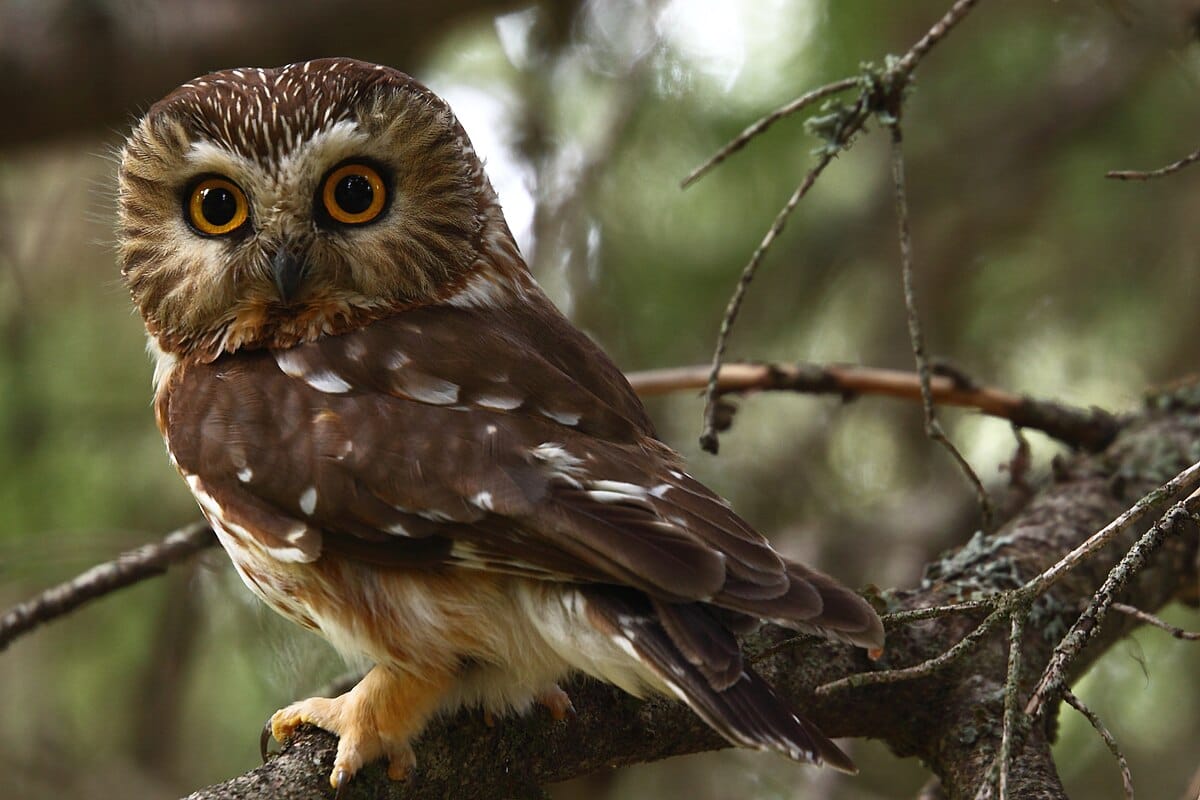
The Northern Saw-whet Owl is one of the smallest and most endearing owls in North America. Measuring just 7 to 8 inches tall, it has a round head with no ear tufts, large yellow eyes, and a beautifully mottled brown-and-white plumage. The name “saw-whet” comes from its repetitive, high-pitched call that resembles the sound of a saw being sharpened—a curious and unforgettable tune of the night forests.
This tiny owl inhabits dense coniferous forests from Canada to the northern United States and even parts of Mexico. Despite its wide range, it is rarely seen due to its nocturnal habits and excellent camouflage. During the day, it roosts quietly in evergreen trees, often near the trunk, perfectly blending into its surroundings. At night, it becomes an efficient hunter of small mammals, especially deer mice, which make up the bulk of its diet.
In winter, some Northern Saw-whet Owls migrate southward, and during this time they are occasionally found in suburban parks and gardens. Bird banding programs have revealed fascinating details about their secretive migrations across the continent. These owls are proof that even the tiniest predators can be fierce and skilled. With their adorable expressions and quiet resilience, Northern Saw-whet Owls have captured the hearts of birdwatchers everywhere.
22. Boreal Owl (Aegolius funereus)
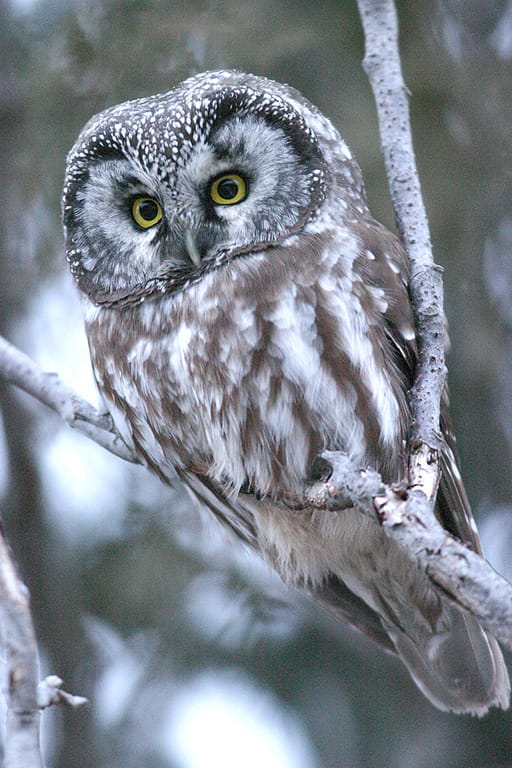
The Boreal Owl, also known as the Tengmalm’s Owl in Europe, is a small, elusive bird that inhabits the cold coniferous forests of the Northern Hemisphere. With a rounded head, yellow eyes, and striking white facial markings, it is a beautiful yet mysterious owl that few people ever get to see in the wild. Its haunting, flute-like call often echoes through northern forests on still winter nights, announcing its presence long before it is seen.
These owls prefer mature spruce and fir forests where they nest in tree cavities—often old woodpecker holes. Their diet consists mainly of small mammals like voles and shrews, which they catch with remarkable accuracy, even under the cover of snow. Their hearing is extraordinarily sensitive, allowing them to pinpoint prey moving beneath thick layers of ice or leaf litter.
Boreal Owls are solitary and shy, making them a challenge to study. Their populations fluctuate depending on prey abundance, and they may move southward during years when food is scarce. In folklore, they are often seen as spirits of the northern woods—quiet guardians of the frozen wilderness. Spotting a Boreal Owl in the wild is a rare and magical experience, treasured by birders who venture into the remote northern forests.
23. Northern Pygmy Owl (Glaucidium gnoma)
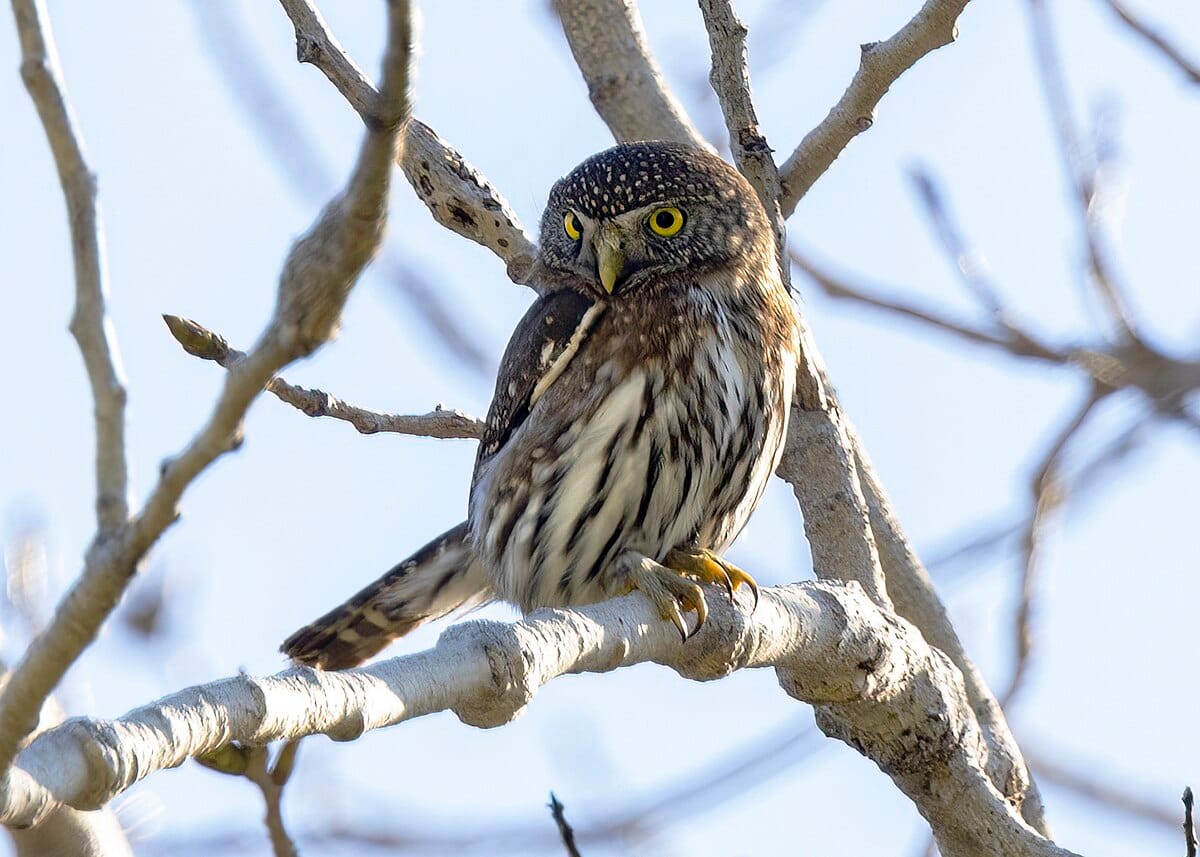
The Northern Pygmy Owl might be small—only about 6 to 7 inches in length—but it carries the heart of a true predator. Found across western North America from Alaska to Central America, this tiny owl is one of the few active during the day. Its bold behavior and daylight activity make it a favorite among birdwatchers who are lucky enough to spot it perched on a high branch, scanning for movement below.
Its brownish plumage, white spots, and deceptive “eye spots” on the back of its head help protect it from larger predators. The Northern Pygmy Owl’s hunting skills are astonishing for its size; it preys on small birds, rodents, and even insects. Birders are often shocked to see this tiny owl carrying prey almost as large as itself—a testament to its fierce determination and agility.
Unlike many other owls, the Northern Pygmy Owl is more often heard during the day, emitting a series of soft toots. They prefer coniferous or mixed forests but can also adapt to open woodlands and suburban areas. Their nesting typically occurs in abandoned woodpecker holes. Despite their size, they play a vital role in balancing ecosystems by controlling small animal populations. Observing one in the wild is a reminder that strength often comes in the smallest packages.
24. Ferruginous Pygmy Owl (Glaucidium brasilianum)
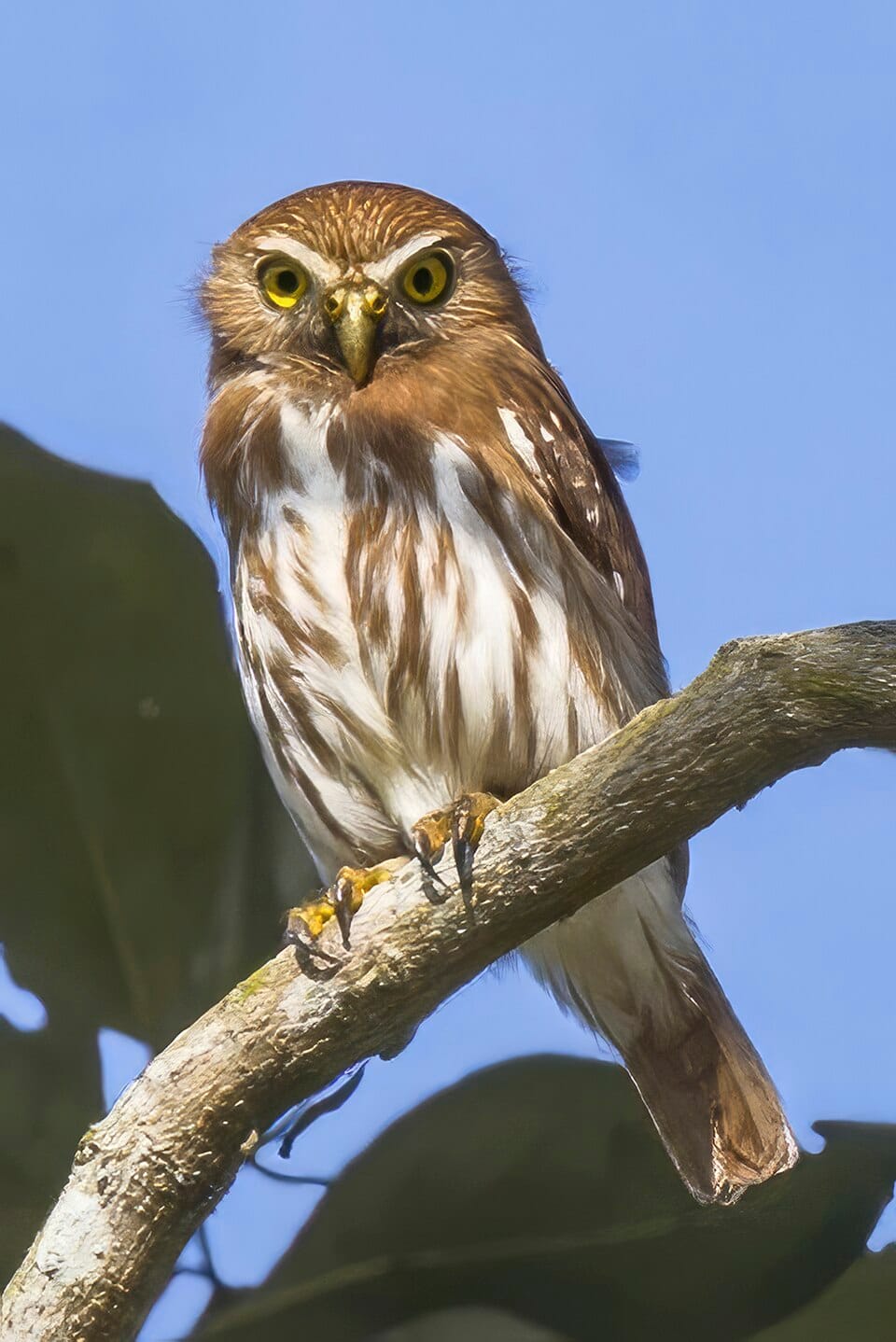
The Ferruginous Pygmy Owl is a small but charismatic species native to Central and South America, with populations also found in southern Texas and Arizona. Its name comes from the reddish-brown (ferruginous) tones of its plumage. This owl’s expressive yellow eyes and streaked chest give it a lively, alert appearance, making it one of the most easily recognized owls in tropical regions.
Unlike many nocturnal owls, the Ferruginous Pygmy Owl is diurnal, often hunting during the day. Its diet includes small birds, lizards, insects, and mammals. It is known for its daring behavior, sometimes attacking prey larger than itself. The owl’s distinctive call—a series of rapid whistles—is commonly heard echoing through forests and farmlands in the early morning or late afternoon.
Despite its small size, the Ferruginous Pygmy Owl commands great respect among local birds, which often mob it in groups to drive it away. In many Latin American cultures, this owl is both admired and feared, symbolizing vigilance and mystery. Their adaptability allows them to thrive in a variety of habitats, from tropical forests to semi-arid scrublands. The Ferruginous Pygmy Owl proves that the most remarkable wildlife often comes in the smallest forms.
25. Eurasian Pygmy Owl (Glaucidium passerinum)
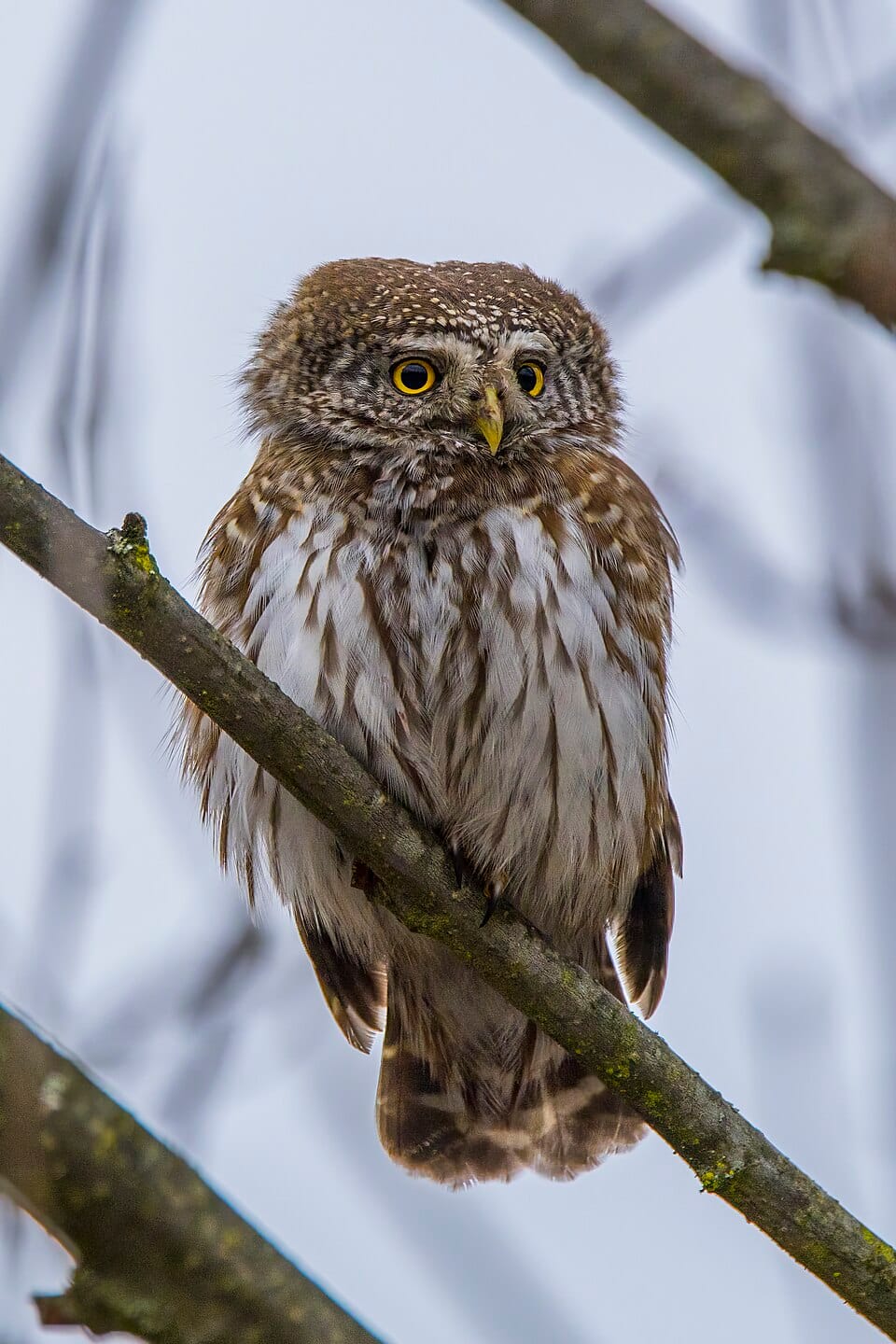
The Eurasian Pygmy Owl holds the title of Europe’s smallest owl, measuring only about 6 inches in length. Despite its tiny size, it’s an accomplished hunter that dominates the forest canopy. Found across northern and central Europe and into Siberia, this owl thrives in coniferous forests, where it uses tree cavities to nest and roost.
With its round head, lack of ear tufts, and fierce yellow eyes, the Eurasian Pygmy Owl is both adorable and formidable. It hunts mainly during dawn and dusk, catching small birds, mice, and insects. One fascinating behavior is its tendency to store extra prey in tree hollows or branches—a smart adaptation for surviving harsh winters when food becomes scarce.
Despite being diurnal, the Eurasian Pygmy Owl is not easy to spot. It moves silently and perches patiently, waiting for the right moment to strike. Its high-pitched, whistling call is often the first clue to its presence. These owls are a favorite among European bird enthusiasts, representing the beauty of small but mighty predators. Their resilience and cleverness make them a marvel of adaptation in the wild.
26. African Barred Owlet (Glaucidium capense)
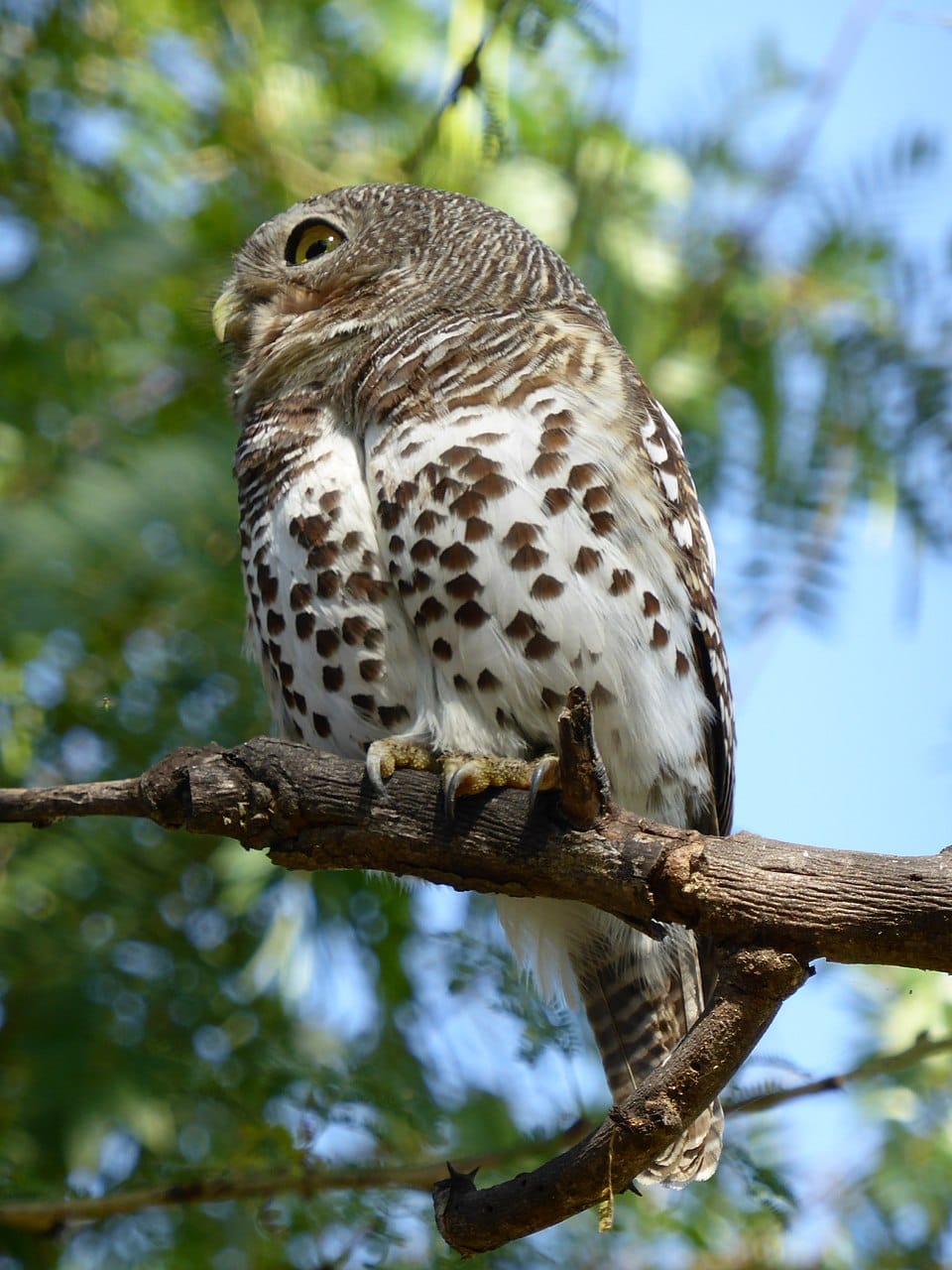
The African Barred Owlet is a charming small owl that brings life to the savannas, woodlands, and forests of sub-Saharan Africa. It belongs to the same genus as the pygmy owls, sharing their petite size and fierce personality. Standing at around 7 to 8 inches tall, this little predator features a rounded head without ear tufts, bright yellow eyes, and beautifully barred plumage in shades of brown and cream. These markings help it blend seamlessly into tree bark—a vital skill for a bird that spends much of its time perched and waiting for prey.
Unlike many other owls, the African Barred Owlet is not strictly nocturnal. It often hunts during the early morning and late afternoon, making it one of the few owls you might see in daylight. Its diet is impressively varied, including insects, small birds, reptiles, and rodents. With incredible agility, it swoops silently through trees, catching prey mid-flight or plucking them from the ground.
This species is known for its clear, whistled call—a rhythmic series of notes that echo softly through the forest canopy. During the breeding season, pairs can be heard calling back and forth in perfect harmony. African Barred Owlets nest in tree cavities, often reusing old woodpecker holes or natural hollows. Despite their small size, they are bold and territorial, defending their nesting areas from intruders much larger than themselves.
For birdwatchers exploring African forests, spotting an African Barred Owlet is always a highlight. Their expressive eyes and curious nature make them a delight to observe. They symbolize adaptability and quiet confidence—qualities that define many of Africa’s most remarkable birds of prey.
27. Pearl-spotted Owlet (Glaucidium perlatum)
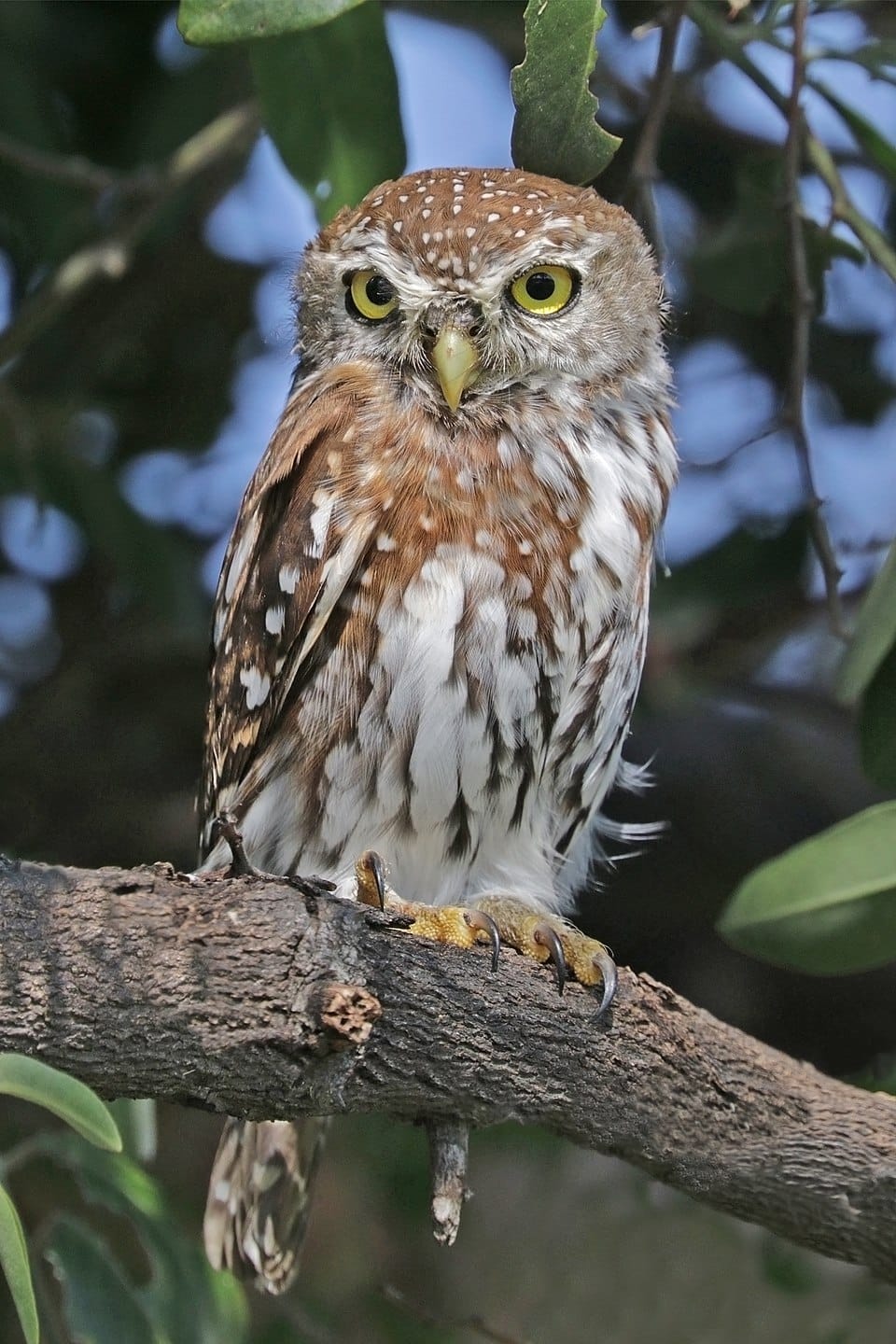
The Pearl-spotted Owlet is one of Africa’s most captivating small owls. Recognized by the pearly white spots that decorate its reddish-brown back and wings, it is both beautiful and bold. Found across much of sub-Saharan Africa, it inhabits savannas, dry woodlands, and thorn scrub regions, often living near human settlements. This adaptability has helped it thrive despite environmental changes.
Measuring about 7 inches in height, the Pearl-spotted Owlet has a rounded head, yellow eyes, and “false eyes” on the back of its head—two black patches that resemble real eyes. These markings are a clever defense mechanism against predators, giving the illusion that the owl is always watching. Unlike most owls, this species is diurnal and highly active during daylight hours, making it one of the easiest owls to spot in Africa.
Its call is a melodious series of whistled notes that gradually accelerate, often mistaken for a songbird’s tune. When hunting, the Pearl-spotted Owlet perches quietly before swooping down to capture insects, small reptiles, or birds. It often caches extra food in tree crevices for later—a smart habit in unpredictable environments.
In local folklore, the Pearl-spotted Owlet is seen as both a protector and a bringer of wisdom. Its presence in rural areas has earned it a special place in the hearts of many African communities. Watching this confident little predator in action is a reminder that courage and intelligence are not defined by size but by spirit and adaptability.
28. Collared Owlet (Taenioptynx brodiei)
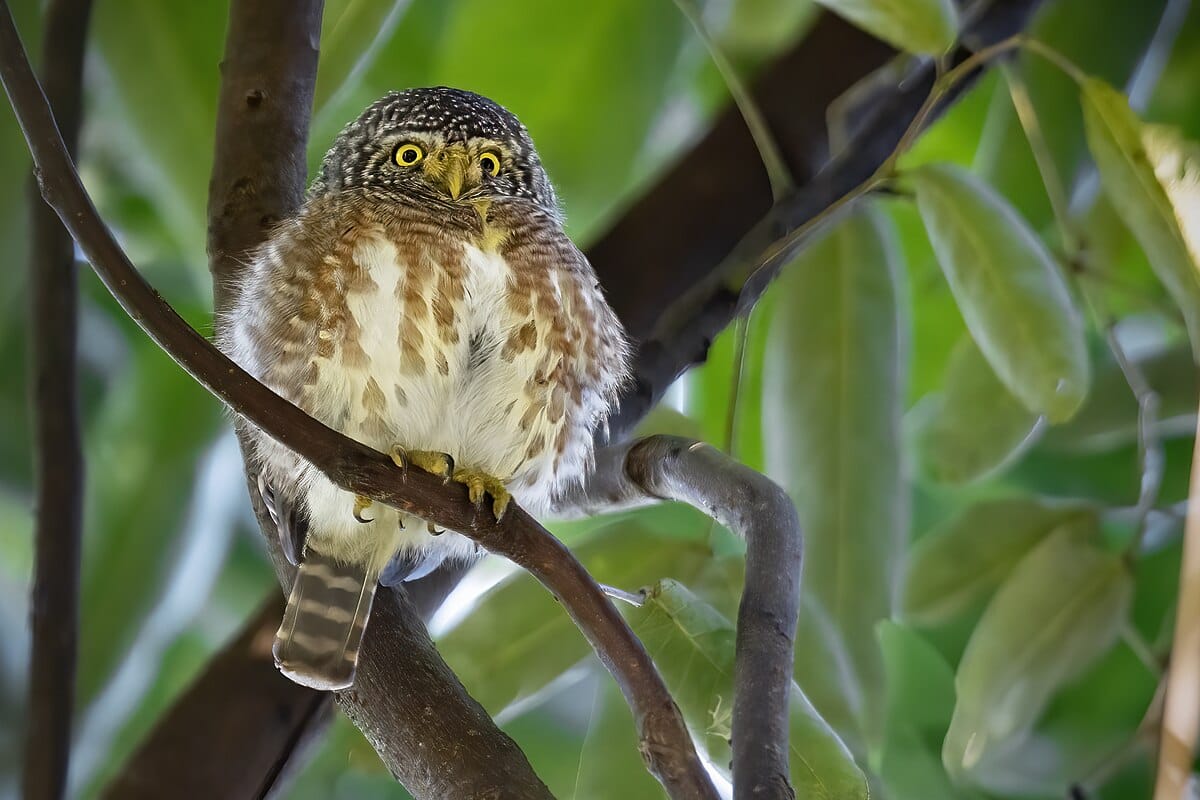
The Collared Owlet, native to South and Southeast Asia, is the smallest owl on the continent—but what it lacks in size, it makes up for in character. Measuring just 6 inches long, this owl is famous for its boldness, often seen flying during the day and chasing away birds much larger than itself. Its distinctive collar-like marking across the neck gives it its name, while its “false eyes” on the back of its head deter predators.
Found in forested hills and mountains from the Himalayas to Indonesia, the Collared Owlet prefers dense woodlands with plenty of tree cover. It feeds mainly on small birds, insects, and lizards, hunting with remarkable precision. Unlike many owls, it is often active during daylight hours, perching openly and calling with a series of soft, repetitive whistles that echo through the trees.
Its plumage is a mix of rufous brown and white streaks, providing excellent camouflage among branches. During breeding season, it nests in tree holes, laying three to five eggs that are fiercely guarded by both parents. The Collared Owlet’s combination of intelligence, agility, and fearlessness has made it a favorite among Asian birdwatchers and nature photographers.
Despite its size, the Collared Owlet represents the spirit of the forest—brave, watchful, and endlessly curious. Its presence is often a sign of a healthy ecosystem, rich with biodiversity and balance.
29. Mountain Scops Owl (Otus spilocephalus)
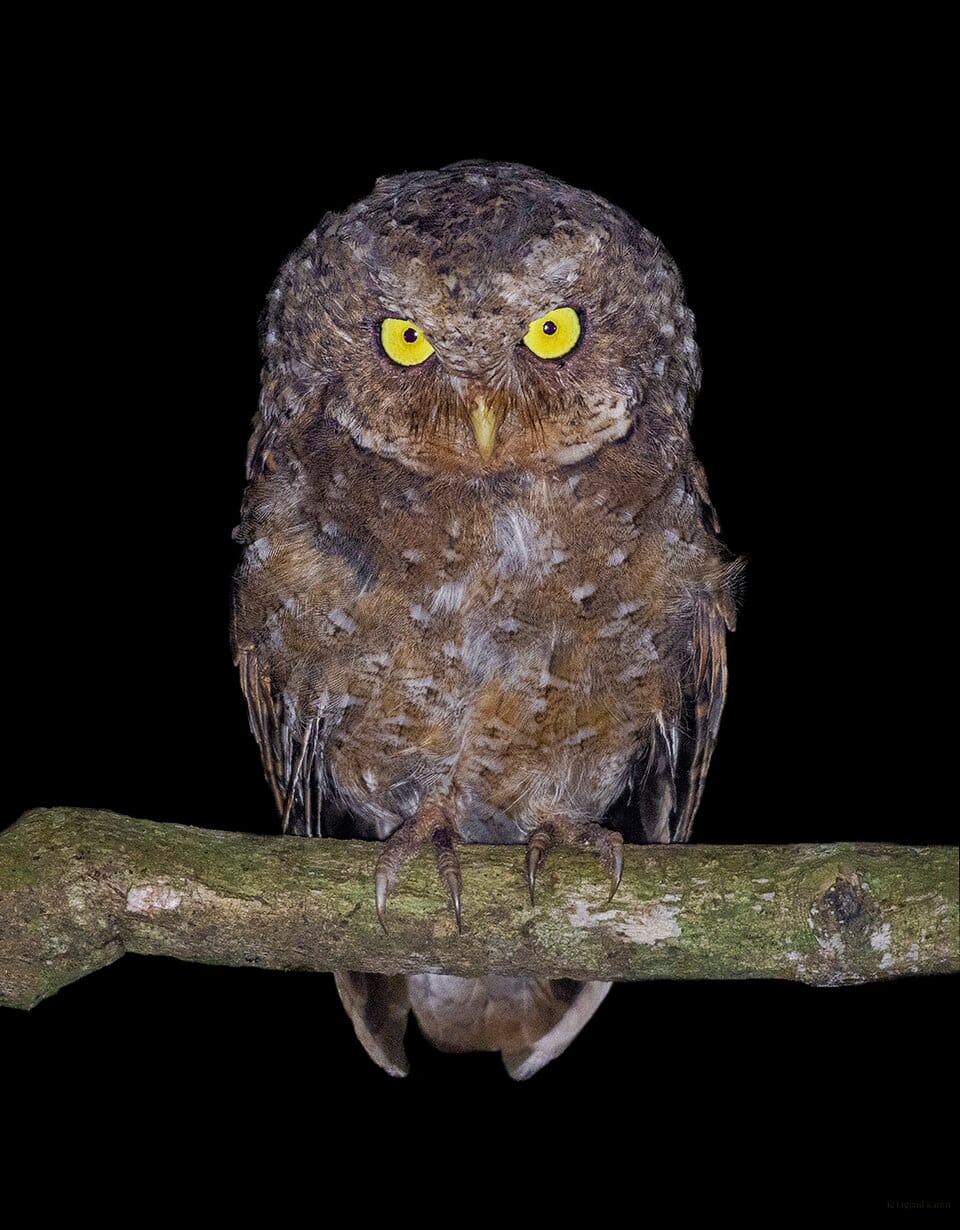
The Mountain Scops Owl is a small, intricately patterned species that inhabits the cool montane forests of South and Southeast Asia. Found in countries like India, Nepal, Thailand, and Malaysia, this owl thrives in dense foliage at elevations between 1,000 and 2,500 meters. Its camouflaged plumage of mottled browns and greys makes it nearly invisible against tree bark—a master of stealth in its misty forest home.
Although small (about 8 inches tall), the Mountain Scops Owl has a powerful voice. Its distinctive two-note call, sounding like “poo-pu,” can be heard echoing through mountain valleys at dusk. This call helps pairs maintain contact and defend their territory. During the day, it roosts silently among vines or mossy branches, becoming active only at night when hunting begins.
Its diet primarily consists of insects, spiders, and small reptiles, which it catches with swift, silent strikes. The Mountain Scops Owl nests in tree cavities, often reusing holes made by woodpeckers. Despite being widespread, it remains difficult to spot due to its secretive habits and exceptional camouflage.
This owl’s mysterious nature and haunting call have made it a favorite among mountain trekkers and bird enthusiasts. It embodies the magic of Asia’s highland forests—hidden, ancient, and full of life.
30. Sunda Scops Owl (Otus lempiji)
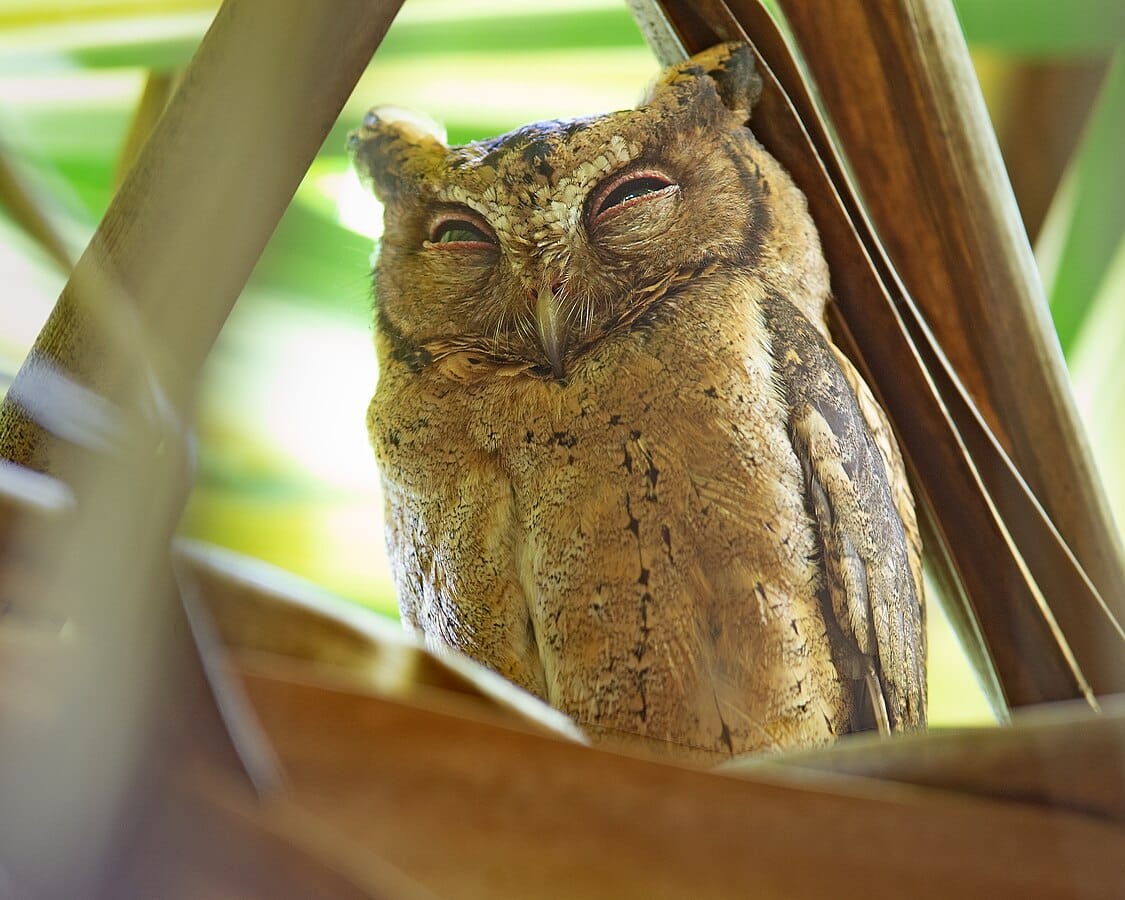
The Sunda Scops Owl, native to the islands of Southeast Asia, is a small but vocal nocturnal hunter known for its distinctive calls that fill the tropical night. Found in Indonesia, Malaysia, Singapore, and the Philippines, it thrives in a wide range of habitats—from lowland forests and plantations to city parks. Its adaptability makes it one of the most commonly encountered owls in the region.
This owl stands about 9 inches tall and features brown plumage with fine streaks, allowing it to blend into tree trunks effortlessly. Its large eyes and short ear tufts give it a classic owl appearance. At night, its calls—a series of short, rising hoots—serve as territorial warnings and communication between mates.
Despite its small size, the Sunda Scops Owl is a capable hunter. It preys on insects, small vertebrates, and even bats. Using stealth and precision, it strikes swiftly from low perches. During the day, it roosts close to tree trunks, relying on its camouflage to stay hidden. When threatened, it stretches its body and narrows its eyes to mimic a branch—a remarkable defensive tactic shared by many scops owls.
In local folklore, the Sunda Scops Owl is often regarded as a messenger of change or wisdom. Its resilience in adapting to urban environments highlights its intelligence and resourcefulness. Whether in dense rainforest or city gardens, this owl’s haunting call connects Southeast Asians to the wildness that still thrives around them.
31. Oriental Scops Owl (Otus sunia)
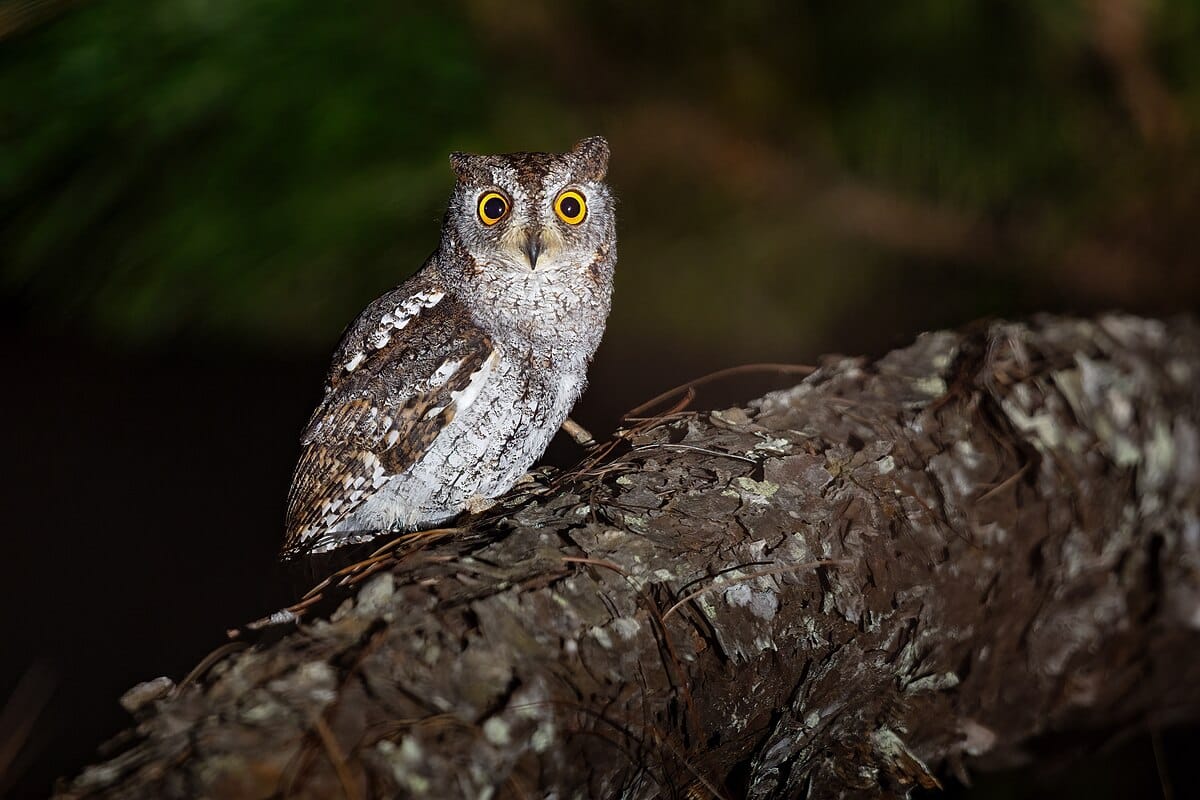
The Oriental Scops Owl is a small yet striking owl species native to Asia, ranging from India and China to Southeast Asia. Measuring around 8 inches tall, this owl is easily recognized by its rufous or greyish plumage, which varies depending on its geographic range. The intricate patterns on its feathers help it blend into tree bark perfectly, offering near-invisibility during the day. When threatened, it elongates its body and narrows its eyes to mimic a branch—a clever camouflage strategy that makes it nearly impossible to spot.
This owl is a master of disguise and sound. Its soft, repetitive “tuk-tuk” call can be heard throughout the night, especially during the breeding season. It inhabits both deciduous and evergreen forests, often close to villages or gardens. While it prefers natural woodlands, its ability to adapt to suburban areas has helped it thrive despite habitat loss.
The Oriental Scops Owl feeds mainly on insects, such as beetles, crickets, and moths, but occasionally takes small lizards and rodents. It hunts silently from low perches, using its acute hearing and night vision to detect even the faintest movement. Nesting usually occurs in tree cavities, where the female lays three to five eggs that are fiercely guarded.
In many Asian cultures, the Oriental Scops Owl is seen as a symbol of wisdom and protection. Its presence in temple groves and rural fields connects it deeply with local folklore. Despite its small size, it stands as one of the most adaptable and resilient owl species across Asia.
32. African Scops Owl (Otus senegalensis)
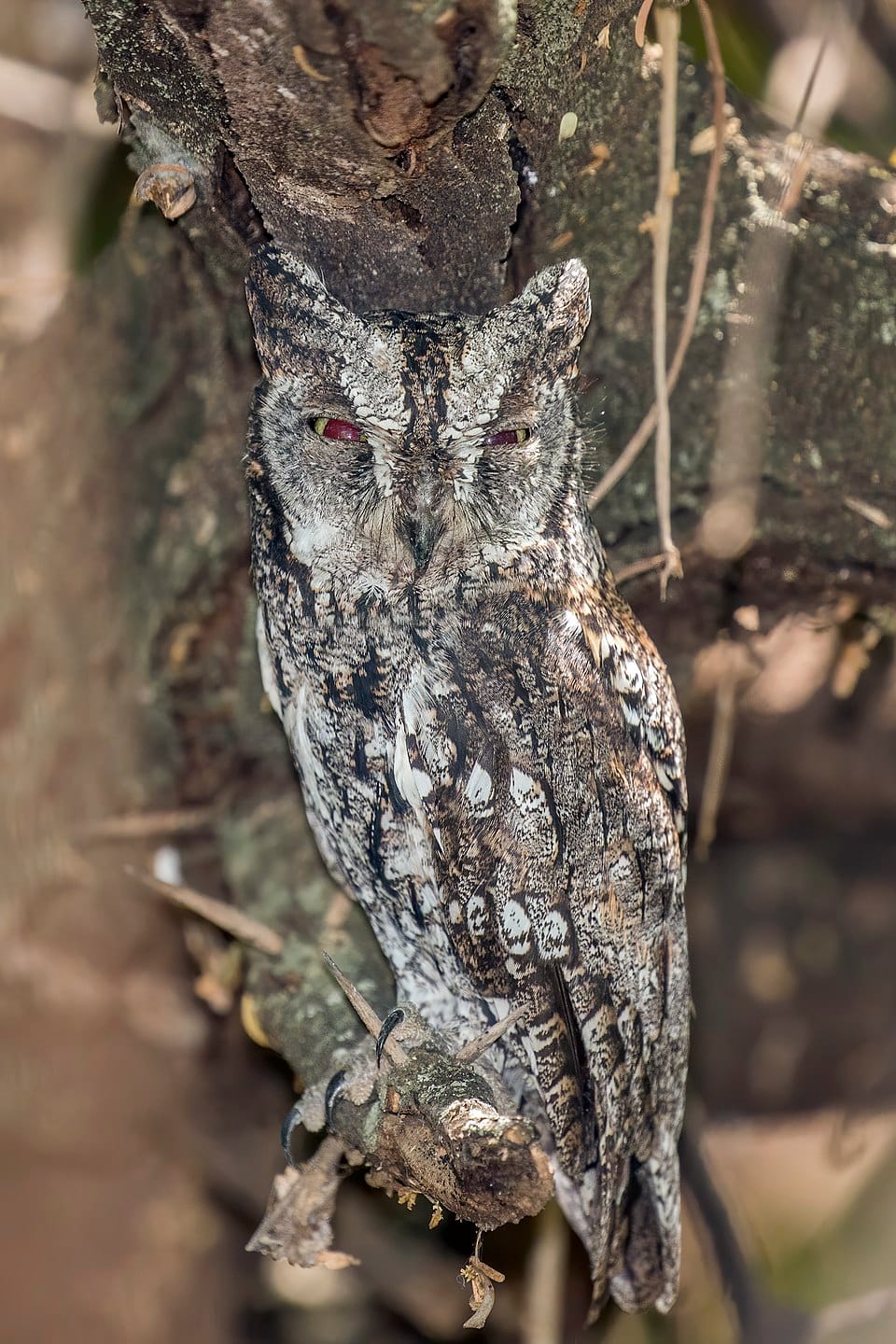
The African Scops Owl is a tiny yet widely distributed owl found throughout sub-Saharan Africa. Standing at just 7 inches tall, it’s one of the smallest owls on the continent—but its voice is unmistakable. Its call, a soft “prrrp” sound repeated at regular intervals, is one of the most recognizable night-time sounds in African savannas and woodlands.
With grayish-brown plumage patterned with fine streaks and mottles, the African Scops Owl blends perfectly into tree bark. This camouflage makes it nearly invisible during daylight hours. It roosts quietly in the same spot every day, relying on its camouflage to avoid predators. At night, it comes alive, hunting moths, beetles, and small vertebrates with surprising agility.
This species thrives in a variety of habitats—from dry acacia savannas to riverine forests and even suburban gardens. It’s an excellent example of how owls can adapt to human-modified environments. During breeding, the female lays eggs in tree hollows, and both parents work together to feed the chicks, demonstrating strong pair bonds.
For African villagers and safari-goers alike, hearing the rhythmic call of the African Scops Owl is a sign that night has settled over the land. Though small and secretive, this owl’s presence adds a touch of magic to Africa’s nocturnal landscape.
33. Madagascar Scops Owl (Otus rutilus)
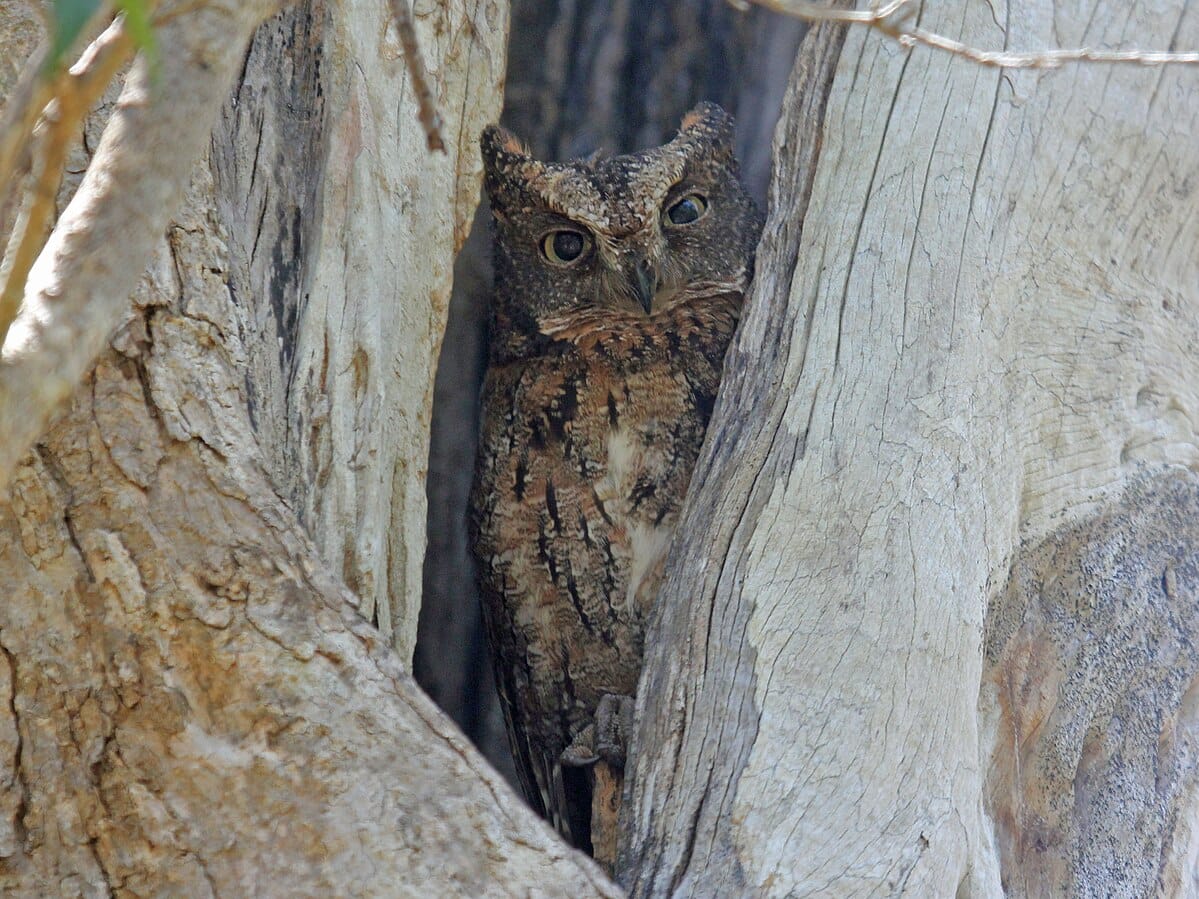
The Madagascar Scops Owl is a fascinating species endemic to the island of Madagascar. Known for its wide range of color morphs—from gray to rich chestnut—it perfectly demonstrates the diversity of life on this unique island. Measuring around 8 inches in length, it has striking yellow eyes, short ear tufts, and a finely streaked chest that helps it blend into forest environments.
This owl inhabits both rainforests and dry deciduous forests, and its adaptability allows it to survive even in degraded habitats near human settlements. Its call is a series of soft, frog-like hoots, usually heard at dusk. The Madagascar Scops Owl primarily feeds on insects and small vertebrates, which it captures with stealth and precision.
Despite being common in some regions, it remains difficult to spot due to its quiet and cryptic nature. During the day, it roosts motionless against tree trunks, relying entirely on camouflage. At night, it becomes an efficient hunter, moving silently through the canopy. It nests in tree cavities, and breeding occurs mainly during the rainy season when food is abundant.
As one of Madagascar’s most iconic nocturnal birds, this species highlights the island’s exceptional biodiversity. Conservation of Madagascar’s forests is vital to ensuring the continued survival of this remarkable owl, which plays a crucial role in controlling insect populations.
34. Seychelles Scops Owl (Otus insularis)
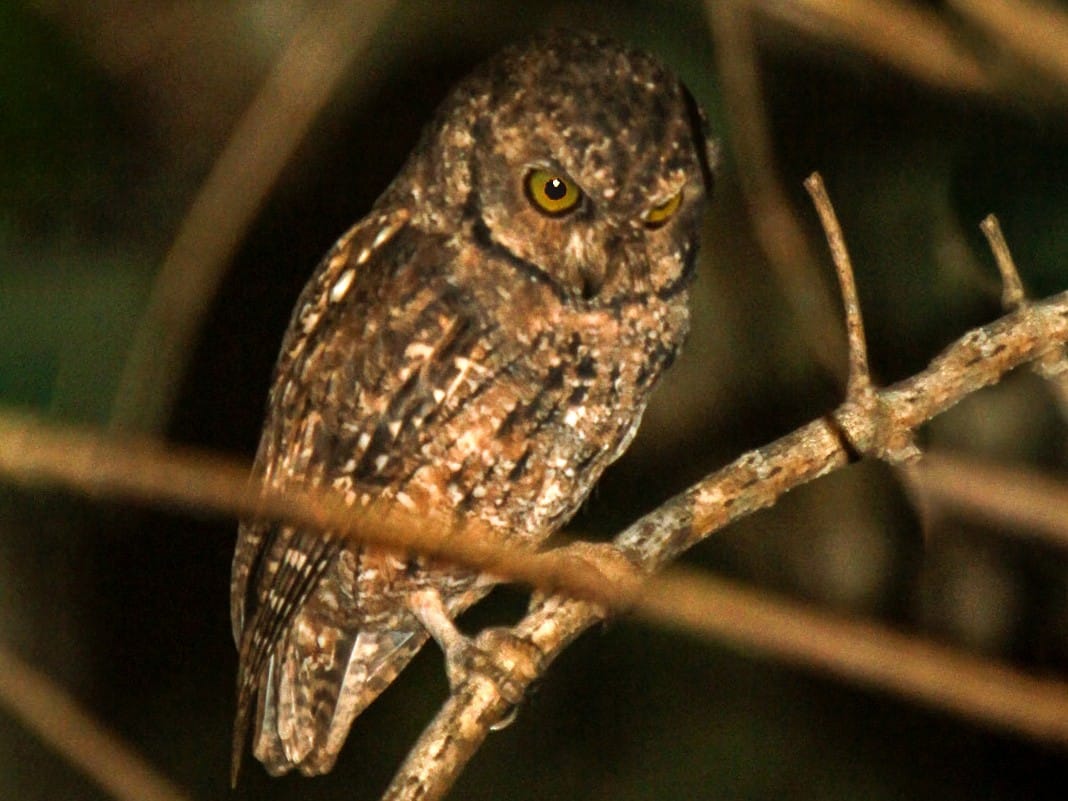
The Seychelles Scops Owl is one of the rarest and most elusive owls in the world, found only on the island of Mahé in the Seychelles. Once thought to be extinct, it was rediscovered in 1959, making it a symbol of hope for island conservation. Small and endearing, it measures about 7 inches in length and has mottled brown plumage with faint barring, perfect for blending into the dense tropical forest it calls home.
Unlike many owls, this species does not have a strong territorial call. Instead, it produces a series of rasping croaks and clicks that echo softly through the misty mountain forests. It feeds on insects, geckos, and small invertebrates, which it catches using short, agile flights through dense foliage.
The Seychelles Scops Owl inhabits high-elevation cloud forests, where it depends heavily on old trees for nesting cavities. Habitat destruction remains its greatest threat, but conservation programs have helped stabilize its population. Efforts to preserve native forests on Mahé are critical to ensuring this owl’s future survival.
To see or hear this owl in the wild is a once-in-a-lifetime experience. Its survival story reminds us of the importance of protecting even the smallest islands of biodiversity. The Seychelles Scops Owl stands as a symbol of resilience and the power of conservation.
35. Palawan Scops Owl (Otus fuliginosus)
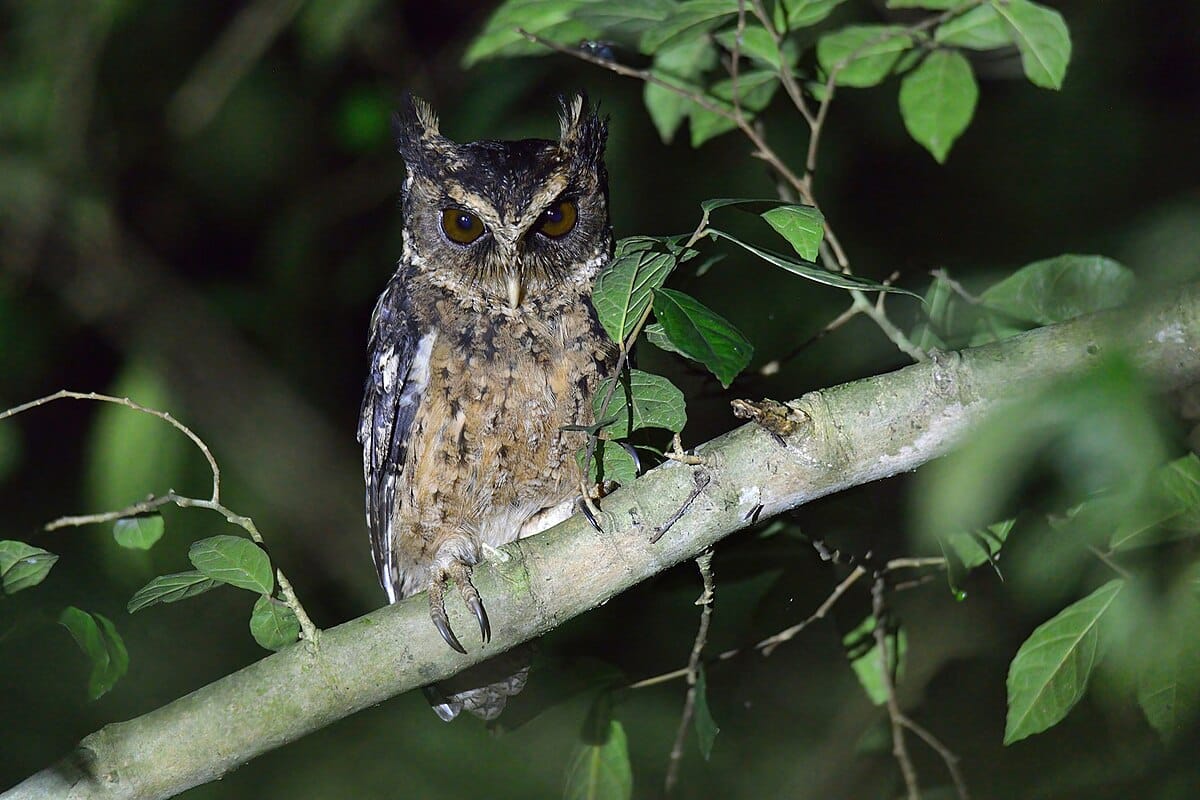
The Palawan Scops Owl is a rare and beautiful owl endemic to the island of Palawan in the Philippines. With deep chocolate-brown plumage, bright yellow eyes, and distinct ear tufts, it is perfectly adapted to the dark understory of tropical forests. It measures about 8 inches long and has a haunting, flute-like call that can be heard echoing through the forest at night.
This species prefers lowland and montane rainforests, where it hunts insects, small birds, and reptiles. It perches quietly on low branches, waiting for movement before striking with precision. During the day, it hides among thick foliage, relying on its excellent camouflage. Unfortunately, deforestation on Palawan has made sightings increasingly rare, placing this owl under significant conservation concern.
In local folklore, the Palawan Scops Owl is believed to be a forest guardian, a spirit that watches over travelers in the dark. This cultural reverence has helped raise awareness about protecting its fragile habitat. Conservationists continue to monitor the species, ensuring that the island’s ancient forests remain a sanctuary for this and many other unique creatures.
With its mysterious presence and melodious calls, the Palawan Scops Owl embodies the wild beauty of the Philippines’ hidden jungles. Every glimpse of it is a reminder of how precious—and vulnerable—our planet’s biodiversity truly is.
36. Long-eared Owl (Asio otus)
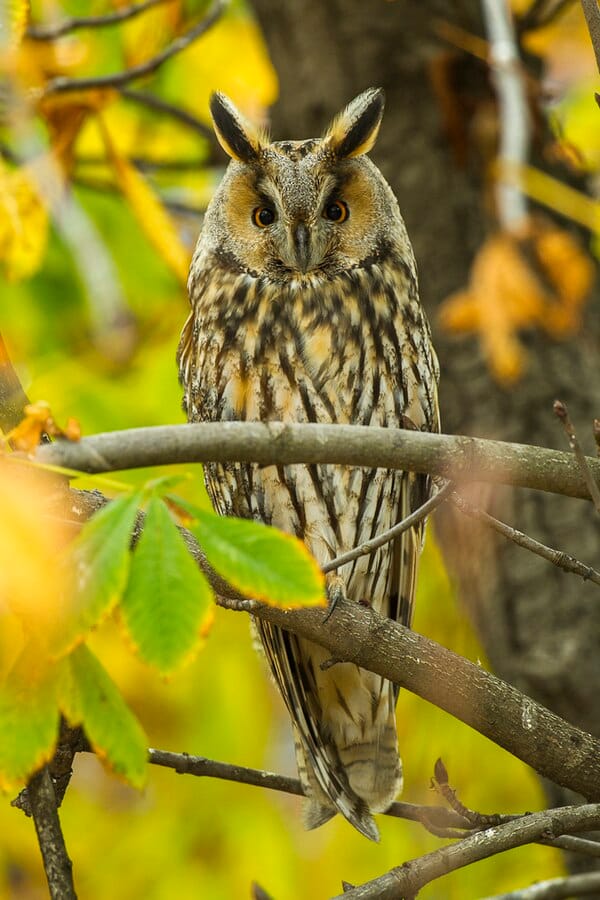
The Long-eared Owl is known for its striking ear tufts that stand tall and give it a perpetually alert appearance. Despite their name, these tufts are not actually ears—they’re just feathers used for camouflage and communication. This medium-sized owl is slender, with a mix of brown, buff, and black plumage that helps it disappear into the bark of trees.
Long-eared Owls prefer open woodlands and grasslands, where they can perch quietly during the day and hunt at night. Their diet consists mainly of small mammals, particularly voles, mice, and shrews. They use their extraordinary hearing to detect prey even under thick vegetation or snow.
During winter, Long-eared Owls sometimes roost communally, with dozens of individuals perched in the same grove of trees. These gatherings can be a spectacular sight for birdwatchers, especially in the northern United States and southern Canada. However, the owls remain vulnerable to habitat loss and disturbance from humans.
Their haunting hoots and silent flight make them both eerie and enchanting to observe. Bird enthusiasts treasure the experience of seeing a Long-eared Owl, as it’s one of the most charismatic species in the owl family.
37. Stygian Owl (Asio stygius)
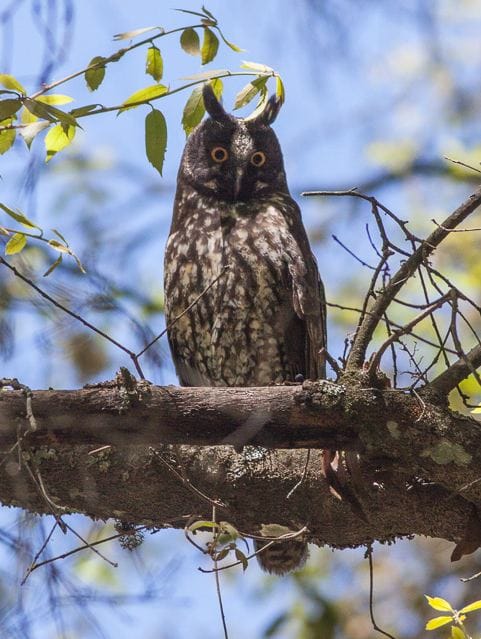
The Stygian Owl is as mysterious as its name suggests—“Stygian” comes from Greek mythology, referring to the River Styx that separated the world of the living from the dead. This large, dark-plumaged owl has haunting yellow eyes and tall ear tufts that give it a ghostly, otherworldly presence.
It inhabits tropical and subtropical forests across Central and South America, from Mexico down to Argentina. The Stygian Owl prefers dense canopies and mountainous regions, where it can hunt bats, small birds, and rodents under the cover of night.
This owl is rarely seen and poorly understood. Its call—a deep, resonant “hoo-hoo”—echoes through the forest at night, giving rise to local legends and superstitions. In some cultures, hearing its call is believed to be an omen, while others see it as a protector of the forest.
Researchers are only beginning to understand its behavior, but what’s clear is that the Stygian Owl plays an essential role in maintaining ecological balance by controlling small prey populations. With continued conservation of tropical forests, we may uncover more secrets about this enigmatic nocturnal hunter.
38. Eurasian Scops Owl (Otus scops)
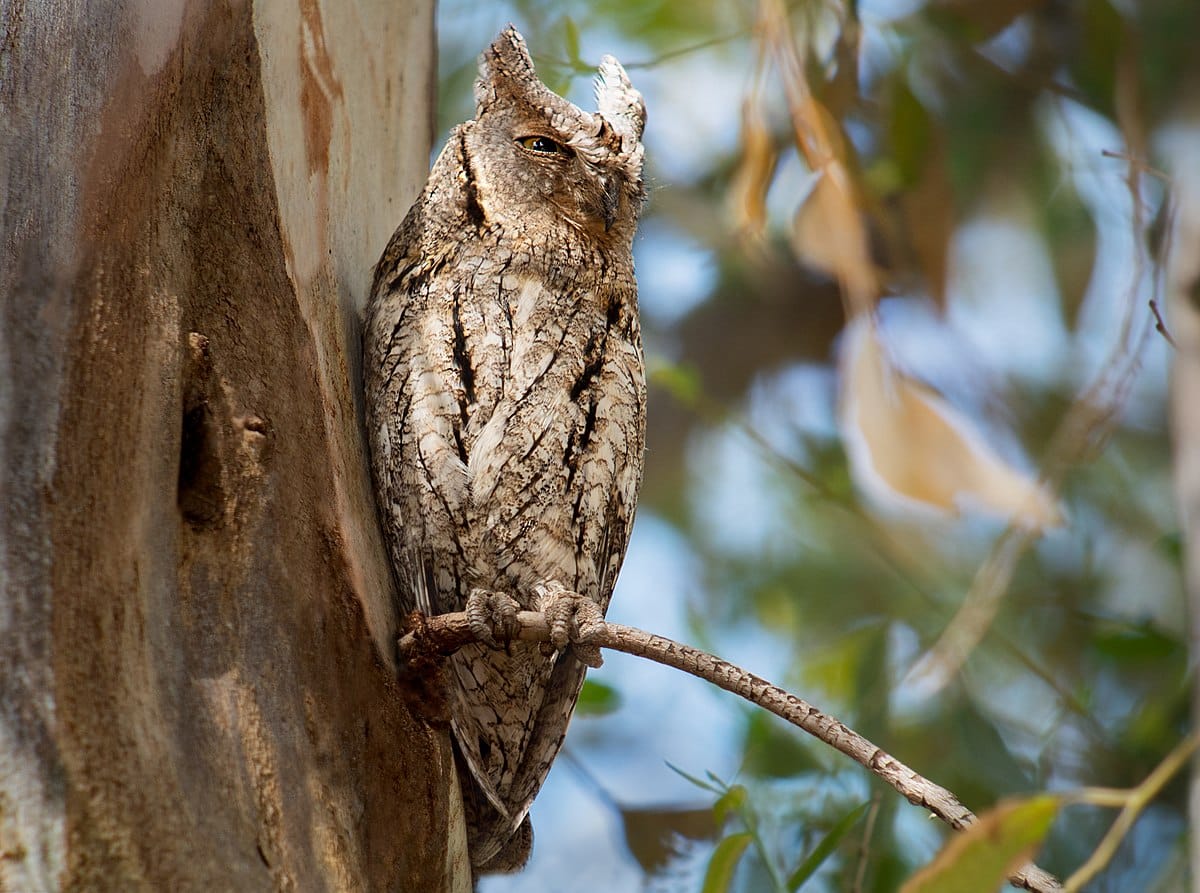
The Eurasian Scops Owl is a small, nocturnal species widely distributed across Europe, Asia, and North Africa. Measuring around 7 inches long, it has brown-gray plumage with fine streaks and ear tufts that blend seamlessly into tree bark. This subtle coloration provides effective camouflage during daylight hours.
This owl primarily feeds on insects, small mammals, and occasionally small birds. It is highly vocal during the breeding season, producing a series of soft, monotonous whistles that can carry over long distances. Nesting occurs in tree cavities or old woodpecker holes, with both parents sharing in incubation and feeding duties.
The Eurasian Scops Owl is known for its incredible adaptability, occupying forests, orchards, and even urban areas. Despite its modest size, it is an efficient predator and plays an important role in controlling insect populations in its ecosystem.
39. Northern Boobook (Ninox japonica)
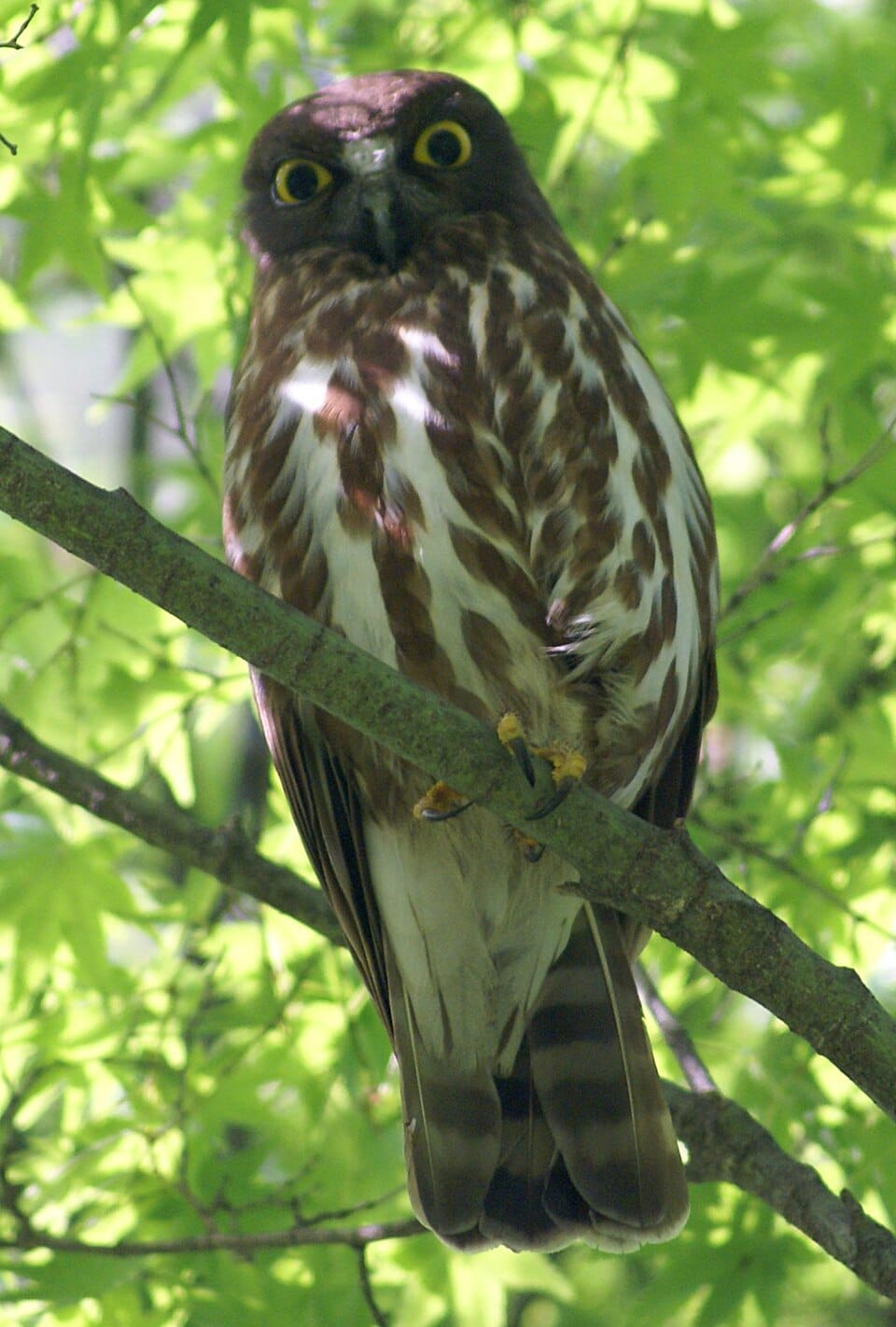
The Northern Boobook is a small, elusive owl found in East Asia, including Japan, Korea, and parts of China. It measures about 8 inches long and has brownish plumage with light streaks and subtle spots that help it remain hidden in dense forests. Its large dark eyes and rounded head give it a watchful, alert expression.
Unlike many owls, the Northern Boobook is primarily nocturnal but can sometimes be active at dawn. Its diet consists mainly of insects, small mammals, and birds, which it captures with rapid, silent flight. Its distinctive call—a series of soft “boobook” hoots—gives the species its common name.
Nesting typically occurs in tree hollows or abandoned nests of larger birds. This owl is secretive and rarely seen, making it a prized sighting for bird enthusiasts. It plays a key role in its ecosystem by controlling insect and small vertebrate populations.
40. Black-and-white Owl (Strix nigrolineata)
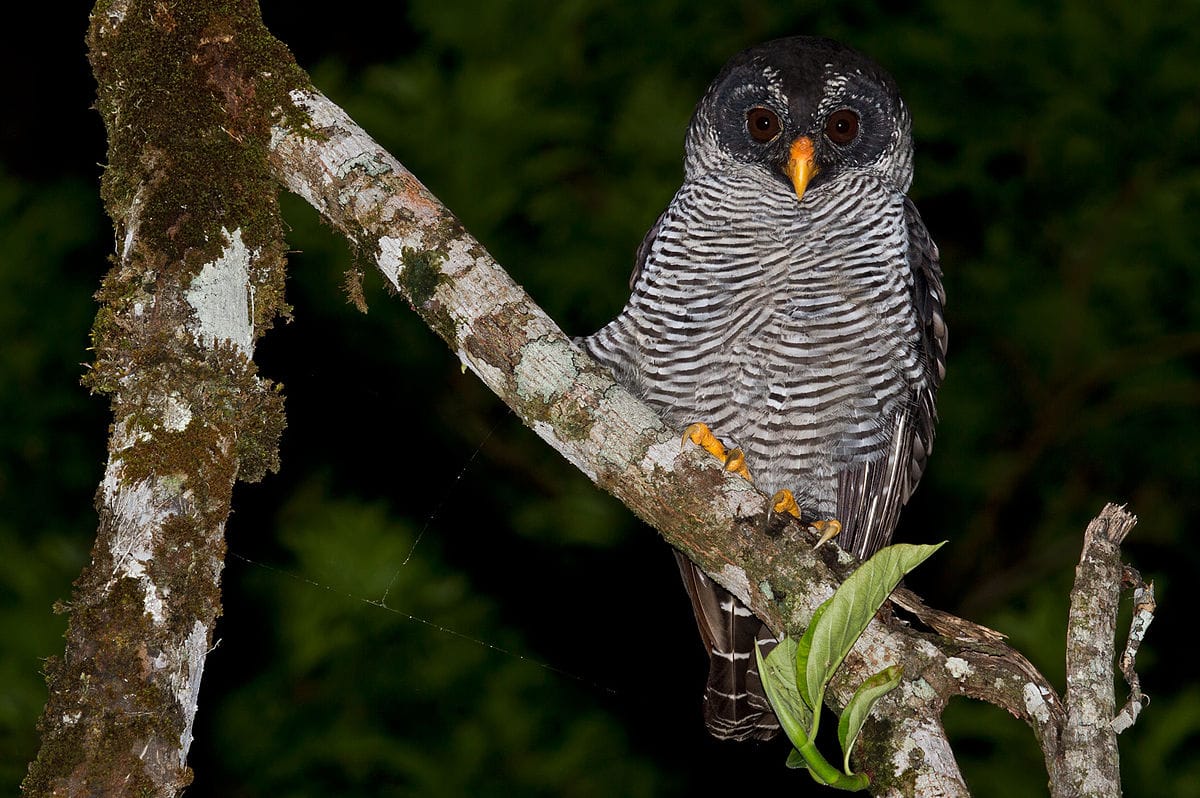
The Black-and-white Owl is a striking species native to Central and South American forests. It features bold black-and-white streaked plumage, large dark eyes, and a rounded head without ear tufts. Measuring around 14 inches tall, it is medium-sized and primarily nocturnal.
This owl inhabits dense lowland forests and feeds on small mammals, birds, and large insects. Its bold coloration provides camouflage among dappled forest light and shadows. Black-and-white Owls are generally solitary and occupy well-defined territories, vocalizing with low-pitched hoots to establish dominance.
The species’ secretive nature makes it challenging to observe in the wild. Birdwatchers consider spotting this owl a remarkable experience due to its beauty, rarity, and enigmatic behavior.
41. Mottled Owl (Strix virgata)
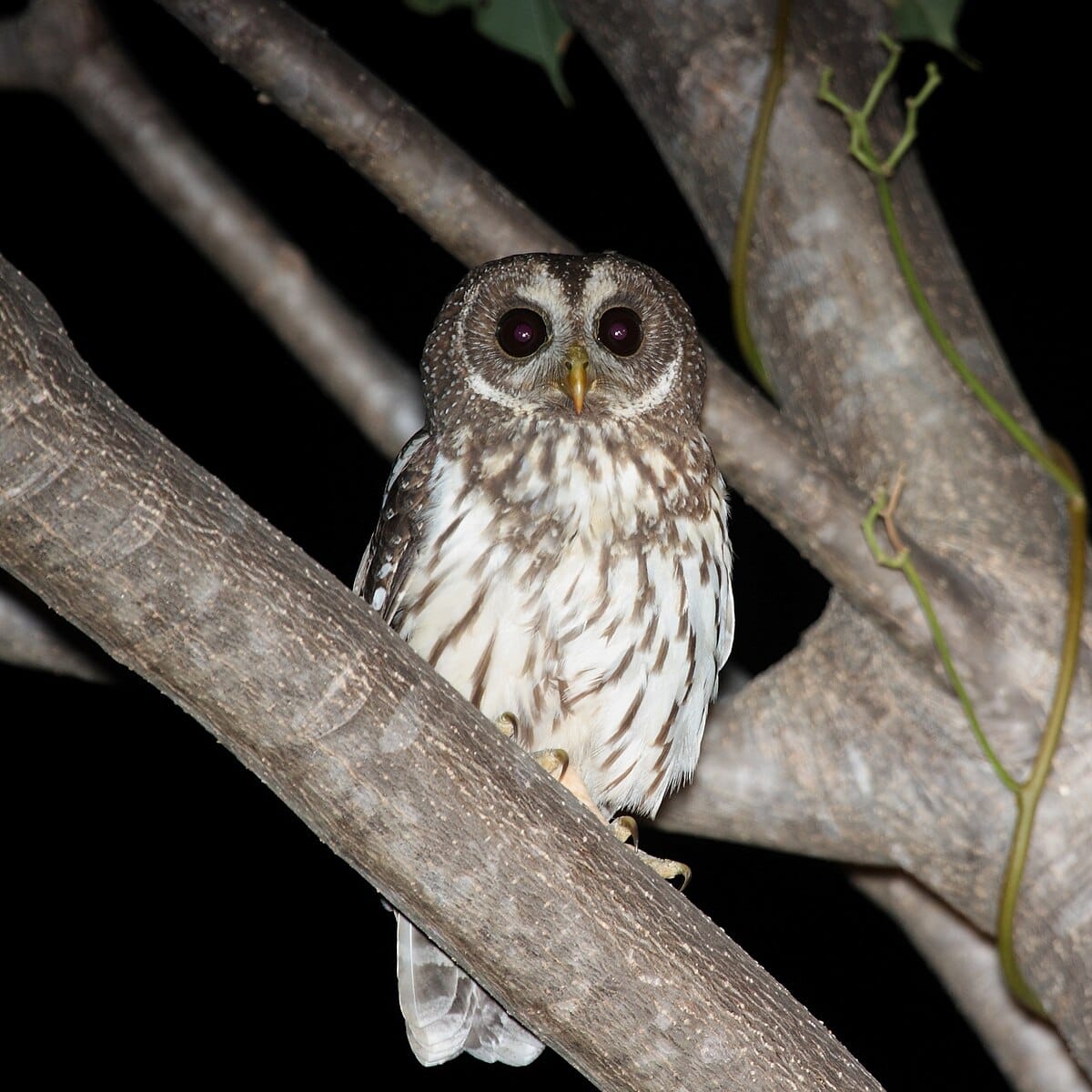
The Mottled Owl is a medium-sized owl found in Central and South America, notable for its dark eyes, mottled brown plumage, and rounded head. It measures about 15 inches long and is primarily nocturnal, hunting insects, small mammals, and birds from dense forest cover.
Its plumage allows it to blend perfectly with tree trunks and branches, making daytime sightings rare. The Mottled Owl is territorial, emitting a series of deep hoots during the breeding season. Nesting occurs in tree cavities or old nests of other large birds, with both parents caring for the young.
Although relatively widespread, habitat loss threatens its populations in some areas. This owl’s adaptability to various forest types highlights its resilience and importance as a nocturnal predator in tropical ecosystems.
Frequently Asked Questions About Owls
1. Which is the most beautiful owl?
The Snowy Owl is often considered the most beautiful, with striking white feathers and bright yellow eyes. Its majestic appearance makes it iconic in popular culture.
2. What is the rarest owl?
The Forest Owlet, found in central India, is extremely rare with very few individuals left in the wild due to habitat loss.
3. What is the most powerful owl?
The Eurasian Eagle-Owl is one of the most powerful, capable of hunting mammals as large as foxes and weighing up to 4 kg.
4. What kind of owl goes hoo hoo hoo?
Many owls make the “hoo hoo” call, but the Barred Owl is well-known for this distinctive three-note hooting sound.
5. What is the satanic owl?
Some cultures call the Barn Owl or the Great Horned Owl “satanic” due to its ghostly appearance and eerie nighttime calls.
6. What’s the most aggressive owl?
The Northern Hawk Owl and the Great Horned Owl can be aggressive, especially when defending their nests or young.
7. Is there a real rainbow owl?
No, there is no real rainbow-colored owl. Some owl feathers may appear iridescent in certain lights, but “rainbow owls” are fictional or artistic depictions.
8. What is a drake owl?
“Drake owl” is not a recognized species; the term may sometimes appear in folklore or fiction.
9. What is the big extinct owl?
The Giant Hawaiian Owl (Pueo, extinct form) or Ornimegalonyx from Cuba were enormous owls that are now extinct.
10. What god uses owls?
In Greek mythology, Athena, the goddess of wisdom, is associated with owls, symbolizing knowledge and protection.
11. What is the fastest owl?
The Short-eared Owl can fly swiftly while hunting, but owls generally prioritize silent gliding over speed.
12. What is a power owl?
“Power owl” is not a scientific term, but it often refers to large, dominant owls like the Great Horned or Eurasian Eagle-Owl.
13. Which owl twit twoos?
The Tawny Owl is famous for its “twit-twoo” call, often heard in European forests during the night.
14. Which owl sounds like a monkey?
The Long-eared Owl and some screech owls can make high-pitched, chattering sounds that resemble monkey calls.
15. What kind of owl is in Winnie the Pooh?
Owl in Winnie the Pooh is a fictional Great Horned Owl, wise but comically talkative and forgetful.
16. What is a group of owls called?
A group of owls is called a “parliament,” reflecting their perceived wisdom and stately appearance.
17. Can owls get angry?
Yes, owls can become aggressive or defensive, especially when their nest is threatened or they feel cornered.
18. How to attract an owl?
Provide a quiet habitat, tall trees, and a food supply like rodents. Installing nest boxes can also encourage owls to visit.
19. Can an owl turn 360?
No, owls cannot turn 360 degrees, but they can rotate their heads about 270 degrees due to extra neck vertebrae.
20. What is the slowest bird?
The American Woodcock or some flightless birds like the Kakapo are among the slowest in terms of flying and movement.
21. Which owl is awake?
Most owls are nocturnal, active at night, but species like the Northern Hawk Owl or Burrowing Owl can be diurnal or active during the day.
22. Which is the strongest owl?
The Eurasian Eagle-Owl and Great Horned Owl are among the strongest, capable of killing relatively large prey with their powerful talons.
23. Do owls go after dogs?
Generally no, owls do not hunt dogs. They may attack small pets like rodents or rabbits, but adult dogs are too large to be prey.
24. What is a spirit owl?
Spirit owls are often mentioned in folklore as mystical birds representing wisdom, guidance, and messages from the spiritual world.
25. What is the most feared owl?
The Great Horned Owl is feared by many small animals due to its size, strength, and predatory skill.
26. What is the coolest type of owl?
The Snowy Owl and Barn Owl are often considered the coolest due to their striking looks and unique hunting adaptations.
27. What is the least aggressive owl?
The Barn Owl is generally less aggressive and avoids confrontation, focusing on hunting small mammals quietly.
28. Are nighthawks rare?
Nighthawks are not true owls, but nightjars. They are not very rare but can be difficult to spot due to their nocturnal habits and camouflaged plumage.
29. What owl sleeps face down?
The Northern Hawk Owl may appear to sleep in unusual positions, but no owl truly sleeps face down. Most perch upright.
30. What owl is Twilight?
In the “Twilight” book series, the owl is not a main character; owls are mentioned symbolically in some scenes but are not specific species.
31. What does “OVO” stand for?
“OVO” commonly refers to “October’s Very Own,” the brand and label associated with rapper Drake, not related to owls.
32. What is a banshee owl?
The term “banshee owl” is folkloric, referring to owls with loud, eerie calls believed to foretell misfortune.
33. What is a rare owl?
The Forest Owlet and Blakiston’s Fish Owl are examples of rare owls with small populations and limited habitats.
34. Are dragon owls real?
No, dragon owls are mythical creatures from fantasy; no owl species has dragon-like features.
35. Are elf owls real?
Yes, Elf Owls are real. They are the smallest owls in the world, measuring about 5–6 inches long and living in southwestern North America.
36. What is the owl that looks like the devil?
The Barn Owl’s ghostly face and dark, hollow eyes have earned it nicknames like “devil owl” in folklore, though it is harmless.
37. Which owl is the most quiet?
The Barn Owl is one of the quietest, with specialized feathers that allow silent flight for hunting.
38. Is there a barn owl?
Yes, the Barn Owl is widespread, found on every continent except Antarctica, easily recognized by its heart-shaped face.
39. Do wolves eat owls?
Wolves rarely eat owls. Owls are mostly nocturnal and small compared to wolves, so they are not typical prey.
40. What does “bubo bubo” mean?
“Bubo bubo” is the scientific name for the Eurasian Eagle-Owl, one of the largest owl species in the world.
41. Can you have a pet owl?
Owls are not suitable as pets for most people. They are wild, require specialized care, and keeping them is illegal in many countries without permits.
42. What is the smallest owl?
The Elf Owl is the smallest, measuring only 5–6 inches and weighing about 1.4 ounces, living in desert and woodland habitats.
Conclusion
Owls are among the most fascinating and diverse birds of prey, showcasing an incredible range of sizes, colors, and behaviors across the globe. From the tiny and fearless Collared Owlet to the majestic Eurasian Eagle-Owl, each species has adapted uniquely to its environment, whether it be dense tropical forests, arctic tundras, or suburban gardens. Observing these remarkable creatures not only offers insight into the intricacies of nocturnal life but also highlights the importance of conservation to protect their habitats.
By understanding the habits, calls, and ecological roles of these 41 owl species, bird enthusiasts and researchers can better appreciate their critical role in maintaining balanced ecosystems. Whether you are a seasoned birdwatcher or a beginner eager to explore the night skies, learning about owls deepens your connection with nature and inspires awe for the mysterious world of these silent hunters.
Remember, owls are indicators of a healthy environment. Protecting them and their habitats ensures biodiversity thrives for generations to come. So, the next time you hear a soft hoot in the night, take a moment to marvel at the incredible diversity and adaptability of these extraordinary nocturnal predators.
